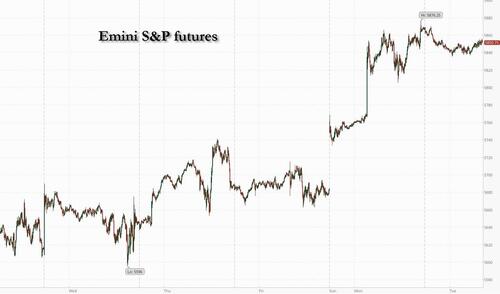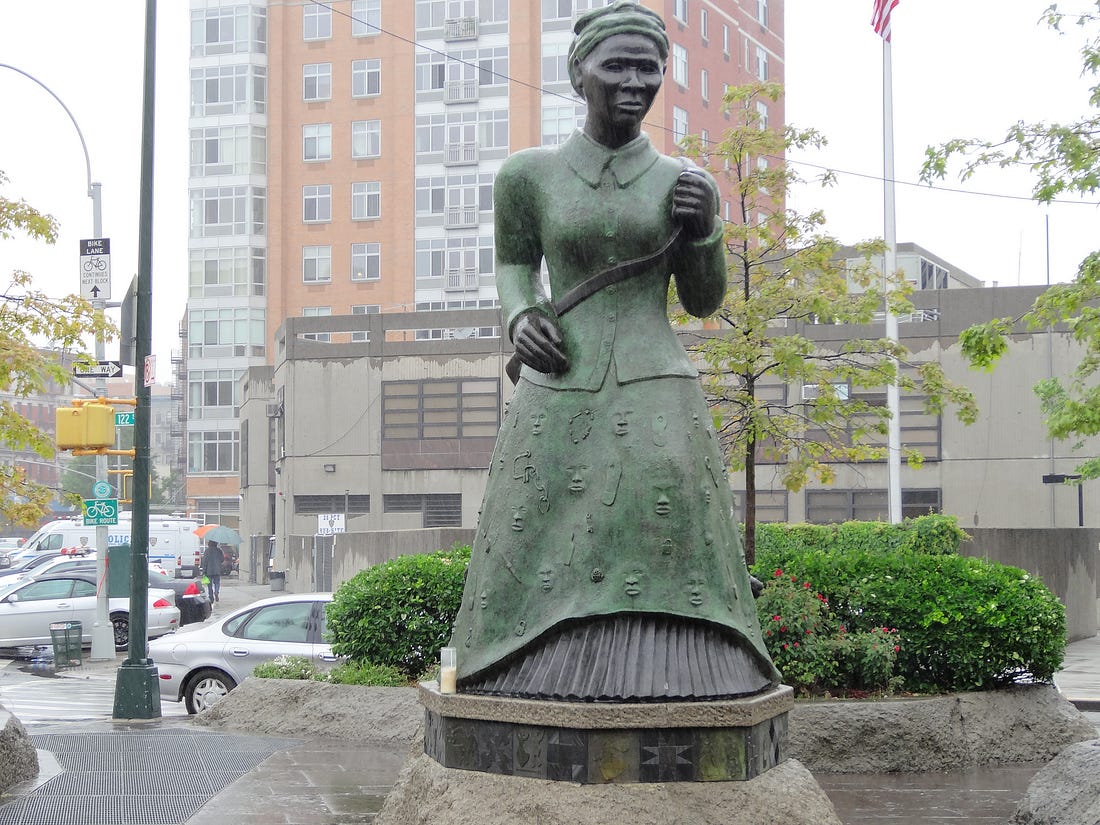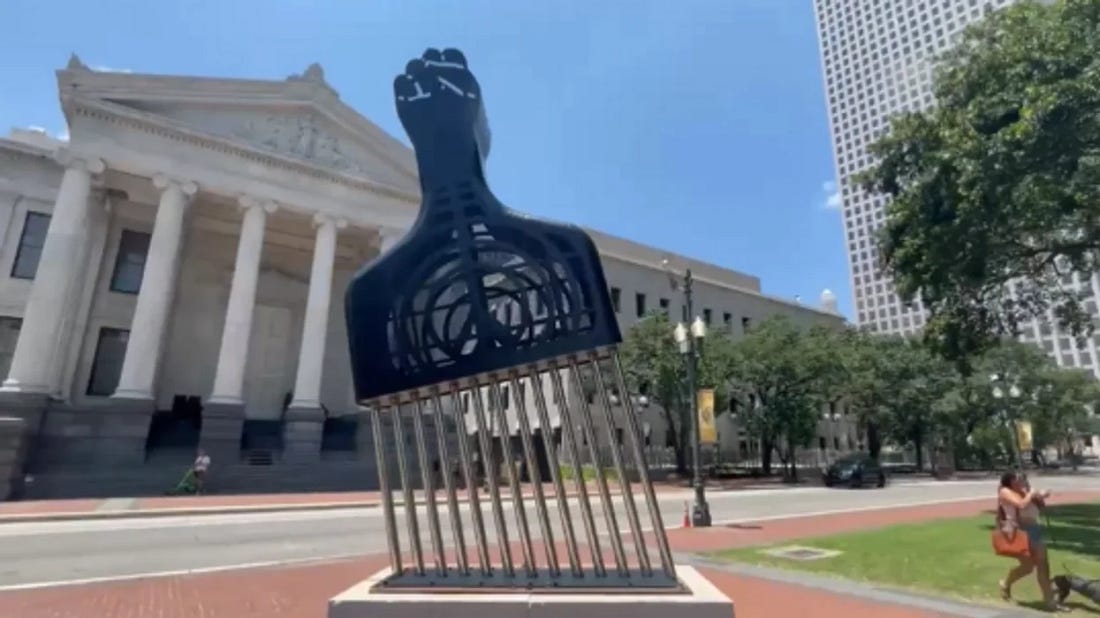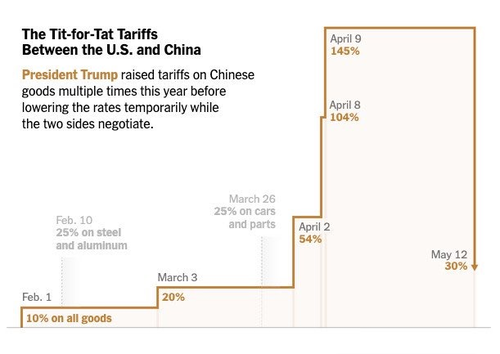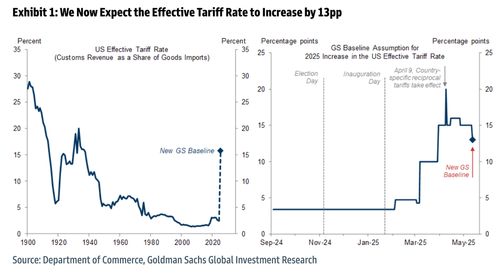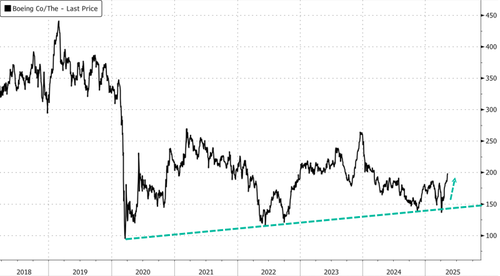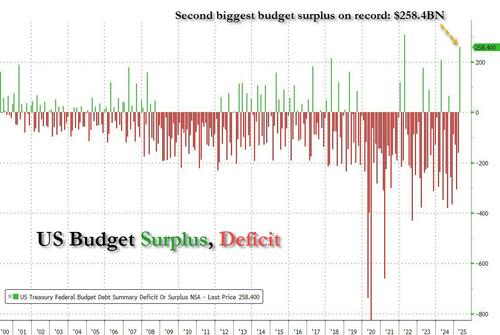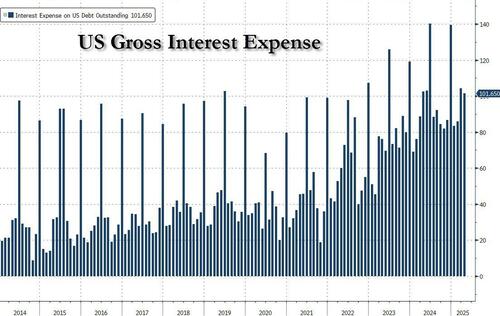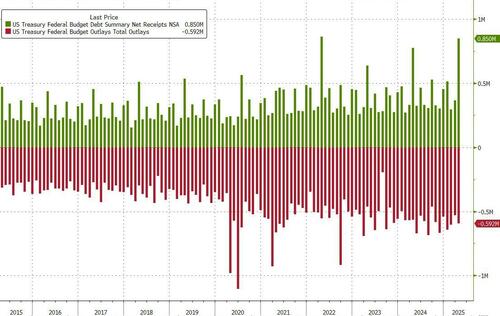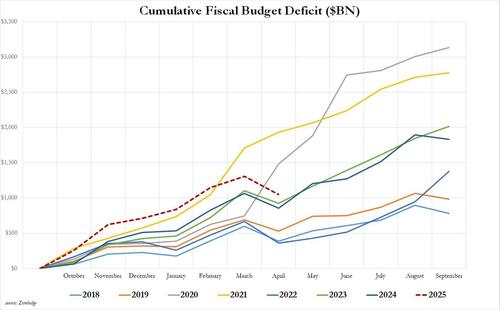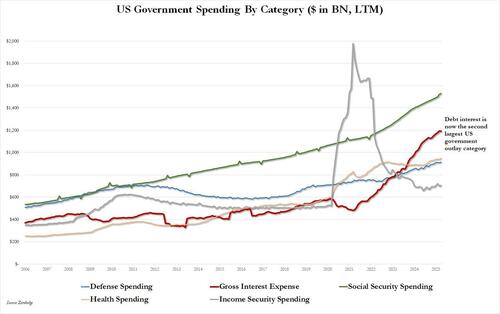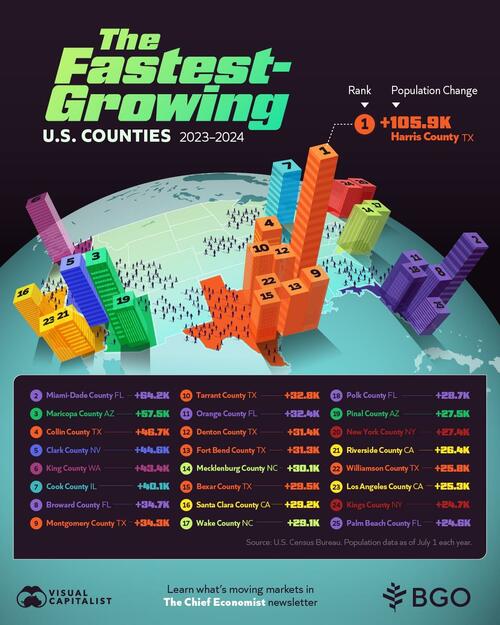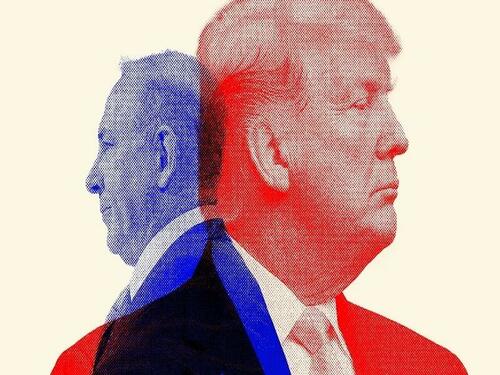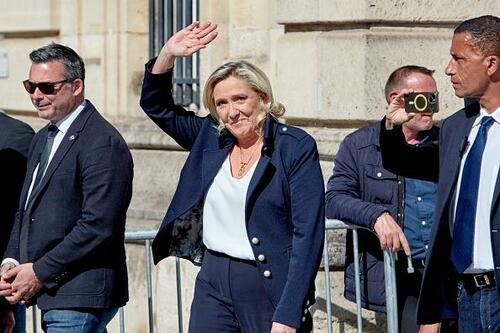For many people today, practical atheism is the normal rule of life...If this attitude becomes a general existential position, then freedom no longer has any standards, then everyting is possible and permissible.
Distinction Matter - Subscribed Feeds
-
Site: Zero HedgeFutures Dip As Torrid Squeeze Pauses Ahead Of CPI ReportTyler Durden Tue, 05/13/2025 - 08:24
US equity futures are modestly lower ahead of today's CPI report, but well off session lows, as markets take a slight pause following yesterday’s surge and as trade war truce euphoria gives way to lingering concerns about inflation and economic growth. As of 8:00am ET, S&P and Nasdaq 100 futures were down 0.2% with Mag7 and Semis names weaker pre-mkt, pulling the index lower. UnitedHealth Group sank 10% in pre-market trading after suspending its 2025 outlook. In the latest trade war news, US reduced the tariff on ‘de minimis’ shipments from China, per Reuters, from 120% to 54%, while China reversed its ban on Boeing jets. Appetite for safer assets picked up again, with Treasury yields falling and gold prices on the rise. The dollar slipped after gaining more than 1.4% yesterday, its strongest day since Nov 6, 2024, the day after the election. Today’s macro data focus is on CPI where the YoY numbers are expected to remain flat MoM despite an acceleration in the MoM prints. Earnings prints are not expected to be market moving today.
In premarket trading, Magnificent Seven stocks were mostly lower with the exception of NVDA (Tesla -0.3%, Meta Platforms -0.2%, Microsoft -0.3%, Apple -0.3%, Alphabet -0.2%, Amazon +0.02%, Nvidia +0.2%). Coinbase Global (COIN) climbs 9% after S&P Dow Jones Indices said the company will join the S&P 500 Index before trading opens May 19. UnitedHealth Group shares drop 10% after the health insurer suspended its 2025 outlook and said CEO Andrew Witty is stepping down for personal reasons, effective immediately. Here are some more notable premarket movers:
- 3D Systems (DDD) sinks 22% after the 3D-printer maker reported products revenue for the first quarter that missed the average analyst estimate.
- Arrowhead Pharmaceuticals (ARWR) climbs 6% after the drug developer reported earnings per share for the second quarter that was ahead of Wall Street’s expectations.
- Enphase Energy (ENPH) drops 5% after BMO cut its recommendation on the solar energy equipment manufacturer to underperform, citing planned Federal Government tax changes as a headwind for residential solar.
- On Holding (ONON) rises 5% after the company nudged its sales growth forecast higher as demand for the Swiss sneaker maker’s high-priced footwear remained strong despite economic uncertainty.
- Pinterest (PINS) declines 2% after the Information reported Google may unveil next week a feature that shows images designed to give people ideas for fashion and other types of designs, citing a person familiar with the matter
- Rigetti Computing Inc. (RGTI) tumbles 11% postmarket after the quantum computing firm’s 1Q revenue missed expectations.
- Other quantum computing stocks are down: Quantum Computing Inc. (QUBT) -3%, D-Wave Quantum (QBTS) -3%
The powerful surge in stocks following the US-China trade truce, which sent the S&P 3.3% higher and erasing all post-Liberation day losses, caught out bearish investors who are now left chasing the rally, as well as hedge funds that were mostly short US equities, according to strategists. Bank of America’s latest fund manager survey — conducted before the US-China trade breakthrough — is “bearish enough to suggest pain trade modestly higher,” Michael Hartnett said. BBVA strategists said that hedge funds’ net leverage is near five-year lows and mostly short US equities, adding to the squeeze.
“Yesterday’s move was warranted,” said Andrea Gabellone, analyst at KBC Securities. “But I need more to get more fundamentally constructive.”
Still, Tuesday’s slight pullback suggests trade and economic concerns are lingering, despite the US-China truce. The dollar is a bit weaker, and gold is higher, as investors await April’s CPI number for a sense of whether Trump’s tariff back-and-forth is fueling inflation. Boeing will be in focus after China removed a ban on airlines taking delivery of its planes.
“The challenges are not over,” said Frederique Carrier, investment strategy head at RBC Wealth Management. “The de-escalation was a lot stronger than even the best hopes, but you have to remember that the US economy still faces average effective tariffs of more than 13%.”
There’s also plenty from strategists to digest. Goldman’s David Kostin raised his 12-month target for the S&P 500 to 6,500 from 6,200, implying a gain of about 11%. But he’s still somewhat cautious, seeing an “impending slowdown in economic and earnings growth.” Meanwhile, the market rebound prompted Mark Haefele, chief investment officer at UBS Global Wealth Management, to cut US stocks to neutral from attractive, saying the risk-reward was now more balanced. Uncertainty is still high, he wrote in a note on Tuesday, and investors will focus on whether a lasting trade agreement can be forged between the two countries.
In Europe, the Stoxx 600 rises 0.2%. Health care stocks are among the biggest gainers, with Bayer shares rising 8% after earnings beat expectations. Insurance names provide a drag after disappointing numbers from Munich Re. Here are the biggest movers Tuesday:
- Renewable energy stocks rally in Europe on Tuesday after US House Republicans proposed a phase-out of incentives to develop clean-energy projects that was better than feared, according to analysts
- Bayer shares jump as much as 10%, the most since August, after the German conglomerate reported better-than-expected earnings and sales for the first quarter
- Grifols gains as much as 6.5% after the the Spanish blood-plasma company delivers results above expectations in the first quarter and maintains its full-year guidance
- Entain rises as much as 6.3% in London after UBS raised its recommendation to buy, saying the bookmaker has been steadily progressing operationally over the past year, yet the shares have underperformed the sector
- RS Group rises as much as 7.5% as BofA Global Research raises its recommendation on the electronics distributor to buy due to an automation recovery and cost savings that support margins
- Munich Re falls as much as 5.4% after first-quarter profit slumped because of claims linked to the Los Angeles wildfires and prices for renewals declined
- Hannover Re shares declined 3.8%, the second-worst performer on the Stoxx 600 Insurance Index, after the German reinsurer reported what JPMorgan says are “not a particularly pretty set of numbers”
- DCC shares drop as much as 4.9%, the biggest fallers in the FTSE 100 Index, after the conglomerate’s earnings fell short of expectations, with analysts pointing to weakness in its technology business due to weak demand
- GEA Group drops as much as as 3.6% following a double-downgrade to underperform from buy at BofA, which cites a full valuation and weaker food and beverage capex cycle in the firm’s major markets
- Fraport shares fall as much as 4.7%, the most in five weeks. Higher costs in Aviation and a one-off impact from security drove a miss on Ebitda in the first quarter for the operator of Frankfurt Airport
- Alfen slumps as much as 26%, the most since June 2024, after the energy equipment company warned that its full-year revenue is likely to come in at the lower end of the current guidance range
Earlier in the session, Asian stocks eked out gains, with sentiment getting a boost after the world’s two largest economies agreed to a trade truce. Meanwhile, shares in Hong Kong fell after a rally on Monday. The MSCI Asia Pacific Index jumped as much as 1%, before trimming its gains to 0.2%. TSMC, Recruit and Toyota were major contributors to the gauge’s gains. Japanese shares were among the biggest gainers in the region, with the Topix index posting its longest winning streak in nearly 16 years. Benchmarks also advanced in Taiwan and Malaysia. Still, shares fell in Hong Kong as the trade agreement is seen as reducing Beijing’s need to announce any large stimulus. Stocks in mainland China pared early gains to trade little changed. Meanwhile, gauges in India also fell as the tech sector’s rally cooled.
In FX, the Bloomberg Dollar Spot Index slipped as much as 0.3% as positioning in the options market continued to lean against the currency. Kristoffer Kjaer Lomholt, head of FX and corporate research at Danske Bank A/S, said the greenback’s 1% surge on Monday was “all about the unwind of the post-Liberation day trades” even though unlike other assets which have recovered all losses since Liberation Day, the dollar remains the only major asset class that is decidedly lower. The Swiss franc, Swedish krona and Aussie dollar are the best performing G-10 currencies. The Canadian dollar lags with a 0.1% fall against the greenback.
Treasuries also reversed some of the Monday moves. The policy-sensitive US two-year yield fell three basis points after surging 12 basis points amid speculation the tariff truce would bolster the world’s biggest economy. 10-year yields dropped 3 bps to 4.45% and again reversing some of Monday’s move. Bunds fall, with German 10-year yields rising 3 bps. UK 10-year borrowing costs add 2 bps but short end yields are lower after British businesses cut jobs for a third straight month in April.
In commodities, US crude WTI futures rise 0.5% to $62.25. Spot gold has also pared some of Monday’s fall, rising $18 to around $3,254/oz.
Looking to the day ahead now, and the main highlight will be the US CPI release for April. Otherwise, we also got UK unemployment for March and the German ZEW survey for May. From central banks, we’ll hear from the ECB’s Escriva, Makhlouf and Knot, along with BoE Governor Bailey and the BoE’s Pill.
Market Snapshot
- S&P 500 mini -0.2%,
- Nasdaq 100 mini -0.2%,
- Russell 2000 mini -0.1%
- Stoxx Europe 600 +0.2%
- DAX little changed
- CAC 40 +0.2%
- 10-year Treasury yield -2 basis points at 4.45%
- VIX +0.3 points at 18.72
- Bloomberg Dollar Index -0.2% at 123
Top Overnight News
- US Treasury Secretary Scott Bessent said the European Union suffers from a “collective action problem” that’s hampering trade negotiations, downplaying the possibility of a quick agreement with the US’s largest trading relationship. “I think the US and Europe may be a bit slower,” said Bessent. BBG
- The US imported a record $53bn of products used in the pharmaceuticals and medical industry in March as companies rushed to build stockpiles in case Trump hits the sector with tariffs. Imports of pharma products soared around 160% in March from the same month the previous year, and almost doubled from Feb, reaching the highest on Census Bureau records stretching back to 2002. FT
- A House Republican tax bill would raise the SALT cap to $30,000 without increasing taxes on the wealthy. It needs almost unanimous party support to pass. The plan proposes to significantly increase taxes on the richest US universities. BBG
- China removed a month-long ban on Boeing deliveries by airlines, people familiar said, after the trade-talk breakthrough with the US. Officials have started to tell local carriers and government agencies that the restrictions no longer apply. BBG
- White House Executive Order said US will cut the minimum tariff on China shipments from 120% to 54%, and a minimum flat fee of USD 100 is to remain: RTRS
- India proposed tariffs on some American goods in its first retaliation against Trump’s duties on steel and aluminum, even as trade talks continue. BBG
- British businesses cut jobs for a third straight month in April. Wage growth, excluding bonuses, slowed to 5.6% in the first quarter, while the unemployment rate ticked higher. BBG
- The U.S. Court of International Trade is hearing oral arguments Tuesday in a lawsuit challenging Trump’s use of the 1977 International Emergency Economic Powers Act to impose sweeping new tariffs last month, before suspending the highest ones on about 60 trading partners for 90 days. Politico
- U.S. new-vehicle prices surged in April, data released on Monday showed, a sign that the effects of President Donald Trump's auto-tariff measures are rippling through the car market. RTRS
- BofA Fund Manager Survey (pre-US/China trade update): Global fund managers most underweight US dollars in May since 2006 61% of fund managers see soft landing for the economy versus 37% in April; 26% see hard landing, down from 49% in April. Prior to US/China Geneva talks, fund managers saw US tariffs on China goods at 37%. "Positive US-China trade war ceasefire prevents recession/credit event": BofA
Trade/Tariffs
- White House Executive Order said US will cut the minimum tariff on China shipments from 120% to 54%, and a minimum flat fee of USD 100 is to remain.
- USTR Greer said the outcome of US-China tariffs talks was seen as pragmatic, while he added China has agreed to remove countermeasures and noted if things don't work out, China tariffs can go back up.
- Chinese President Xi said there are no winners in tariff wars and trade wars, while he added that only when various countries work together can they maintain world peace, stability and promote global development. Xi said bullying and tyranny will only isolate oneself, as well as noted that China supports Latin America and the Caribbean in expanding their influence in the multilateral arena with China willing to deepen cooperation with Latin America in infrastructure, agriculture, food, energy and minerals.
- China's Foreign Ministry, on US fentanyl tariffs, says China has repeatedly said it is a US issue. US is ignoring China's good will. Responsibility lies with the US.
- US Treasury Secretary Bessent says talks with China in Geneva resulted in a mechanism to avoid escalation; can proceed from here and have a very good framework. When asked if he feels good about the progress of other deals, he responds "yes"; references Japan, South Korea, Indonesia, Taiwan. Thinks the US-Europe deal may be a bit slower, cites regional divides among the EU.
- Canadian PM Carney and UK PM Starmer agreed to strengthen trade, commercial and defence ties in a phone call, according to a statement from Canada.
- China removes ban on Boeing (BA) deliveries after US trade truce, via Bloomberg.
A more detailed look at global markets courtesy of Newsquawk
APAC stocks traded mostly higher following the rally on Wall St owing to the US-China trade war de-escalation after both sides agreed to cut tariffs by 115ppts for an initial period of 90 days, although some of the gains were capped as the euphoria began to moderate. ASX 200 edged higher amid outperformance in tech and energy but with further advances contained by weakness in defensives and gold miners. Nikkei 225 rallied to above the 38,000 level following the cooling in US-China trade tensions but with the index off intraday highs amid some profit-taking and a slight pullback in USD/JPY, while BoJ rhetoric continued to signal future hikes if prices and the economy improved. Hang Seng and Shanghai Comp lagged despite the de-escalation in the US-China trade war which the Hong Kong benchmark already had its opportunity to react to yesterday, while questions lingered on what will happen during the 90-day reprieve as the trade deficit remains and the current 30% tariff on Chinese goods still a relatively high level.
Top Asian News
- BoJ Summary of Opinions from the April 30th-May 1st meeting stated that one member said the central bank is likely to continue raising interest rates in line with improvements in the economy and prices, while a member said the BoJ must make policy decisions without preconception as uncertainty over the outlook is very high. There was also the opinion of no change to the BoJ's rate-hike stance as real interest rates are deeply negative, but risks must be scrutinised and the BoJ has little choice but to take a wait-and-see stance until developments surrounding US trade policy stabilise to some extent. Furthermore, a member said that uncertainty surrounding economy and price outlook is high and the likelihood of achieving price goal is not as high as in the past, while it was stated that the BoJ will enter a temporary pause in rate hikes but shouldn't slide into excessive pessimism and must guide policy nimbly and flexibly.
- Nissan (7201 JT) 2024/2025 (JPY): operating profit 69.8bln (-87.7%), net -670.90bln (prev. 426.65bln), Revenue 12.63tln (prev. 12.69tln); withholds FY guidance due to tariffs, will consolidate production plants to 10 from 17. Nissan impact on Renault (RNO FP) Q1 net estimated at EUR 2.2bln loss.
- JD.com (JD/9618 HK) Q1 (USD): EPS 1.16 (exp. 1.05), Revenue 41.5bln (exp. 40.2bln); Co. notes of improving consumer sentiment.
European bourses (STOXX 600 +0.2%) are mostly, but modestly firmer as markets cool a touch from the significant upside seen in the prior session. Price action this morning has been relatively rangebound, given the lack of fresh catalysts thus far. European sectors hold a slight positive bias, but with the breadth of the market fairly narrow. Basic Resources leads, followed closely by Retail and Travel & Leisure to complete the top three. US equity futures (ES -0.4%, NQ -0.5%, RTY -0.5%) are modestly in negative territory, as the complex gives back some of the prior day’s US-China induced upside. Focus this morning has been on Bloomberg reporting which suggests China is lifting its ban on Boeing (BA) deliveries after the US-China tariff pause. BlackRock (BLK) CEO said it still sees global investors overweighting the US; adds that US deficits are still an issue.
Top European News
- Barclaycard UK April Consumer Spending rose 4.5% Y/Y, which was the biggest increase since June 2023.
- ECB strategy review will largely endorse past policies, including QE, despite some policymakers’ criticisms, while the ECB is to keep reference to ‘forceful action’ when rates and inflation are low following the review, according to sources cited by Reuters.
- ECB's Makhlouf says given effects of size, scale and more persistent nature of fragmentation-induced shocks, and their impact on prices, monetary policy responses will need careful calibration.
- BoE's Chief Economist Pill says should not assume that latest MPR forecasts is a direct endorsement of market interest rate curve; worried about potential risks to inflation He does see risk of second round effects. Remain concerned that they've seen a structural change in price and wage setting within the UK. The response of monetary policy to ensure they get inflation back to target may need to be more persistent.
FX
- DXY gives back some of Monday's trade-induced gains. Desks flag the uncertainty rising from the 90-day period in which both the US and China slashed their respective retaliatory tariffs by 115 bps each. Elsewhere on the docket, the highlight will be US CPI, whereby analysts expect US headline CPI to rise +0.3% M/M in April (prev. -0.1%). DXY currently resides in a narrow 101.46-101.73 range, well within yesterday's range, with the 50 DMA today at 101.86.
- EUR is relatively stable and moving in tandem with the Dollar with little action seen on ECB commentary in which ECB's Makhlouf said given effects of size, scale and more persistent nature of fragmentation-induced shocks, and their impact on prices, monetary policy responses will need careful calibration, meanwhile, ECB's Escriva said they must be humble in assessing the current situation, and ECB's Nagel said they shouldn't overreact to individual announcements. Reuters sources overnight suggested the ECB strategy review will largely endorse past policies, including QE, despite some policymakers’ criticisms, while the ECB is to keep reference to ‘forceful action’ when rates and inflation are low following the review. On the data front, May ZEW survey for Germany saw a jump in economic sentiment but an unexpected fall in current conditions - but no real follow through to the EUR.
- Haven FX are clawing back some lost ground as markets take a breather following yesterday's US-China euphoria, and following the aforementioned punchier language from Chian this morning coupled with the accompanying uncertainty provided by the 90-day de-escalation. USD/JPY resides towards the bottom of a 147.65-148.48 range, with the 50 DMA seen at 146.27 today.
- GBP is buoyed by the softer Dollar, with FX markets gaining some composure after Monday's surge in the Buck. UK jobs data this morning did little to shift the dial, with no reaction seen post-release: overall, the labour market continues to soften but at a relatively moderate rate. GBP/USD currently trades in a 1.3166-1.3216 range, well within Monday's 1.3137-1.3299 parameter.
- Antipodeans benefit from the broadly softer Dollar despite a more cautious risk tone across the markets.
- PBoC set USD/CNY mid-point at 7.1991 vs exp. 7.2188 (Prev. 7.2066).
Fixed Income
- USTs are slightly firmer with the risk tone tepid and fixed easing from the lows seen on Monday as the dust settles following tariff announcements between the US and China. At the top-end of a 110-02 to 110-08 band. Attention for USTs is firmly on the April CPI print. A release that is perhaps slightly less pertinent given the recent US-China progress; however, it will still be scrutinised for insight into the Fed’s deliberations. After the data we have remarks from President Trump at 15:00BST in the Middle East. Reports in Axios on Monday suggested he was aiming to return with over a USD 1tln worth of deals.
- Bunds are a touch softer and, in contrast to USTs, has eked out a marginal new WTD trough at 129.43. However, despite this, the narrative is much the same as the benchmark consolidates from Monday’s marked sell off and await fresh insight on EU-US talks. On that, US Treasury Secretary Bessent was out this morning with the same type of language on the EU, describing the progress as being a little slower. On the data front, May ZEW survey for Germany saw a jump in economic sentiment but an unexpected fall in current conditions - but no real follow through to Bund price action.
- Gilts are the marginal underperformer, and in a similar fashion to Bunds the benchmark has made a new WTD low at 91.51 vs 91.63 on Monday. Gapped lower by 13 ticks at the open and then slipped a bit further to the above base. An open that followed the latest UK jobs data which, in summary, showed that the labour market continues to cool but at a gradual pace with the rate of wage growth slowing but still at a level that the MPC is unlikely to regard as being consistent with the inflation target.
- Netherlands sells EUR 1.98bln vs exp. EUR 1.0-2.0bln 2.00% 2054 DSL: average yield 3.228%.
- UK sells GBP 1bln 0.625% 2045 I/L Gilt: b/c 3.19x (prev. 3.48x) & real yield 2.23% (prev. 1.732%).
- Italy sells EUR 7.5bln vs exp. EUR 6.0-7.50bln 2.65% 2028, 3.25% 2032 & 4.45% 2043 BTP.
- Germany sells EUR 3.401bln vs exp. EUR 4.5bln 1.70% 2027 Schatz: b/c 2.2x (prev. 1.7x), average yield 1.94% (prev. 1.67%), retention 24.42% (prev. 23.72%).
Commodities
- Crude has traded choppily, and off the highs seen following the US-China trade deal announcement. Currently WTI & Brent are higher by around USD 0.20/bbl as traders await US CPI and updates from US President Trump who is set to give some remarks at 15:00 BST / 10:00 EDT. Brent Jul'25 sat in a busy USD 64.63-65.12/bbl range for most of the European morning, but has recently climbed out of the top-end of that range to print a peak at USD 65.35/bbl.
- Precious metals are firmer across the board, with some outperformance in spot silver as the complex benefits from the softer Dollar. Spot gold is currently higher by around USD 18/oz, and trades in a USD 3,216.06-3,265.51/oz range.
- Base metals are broadly in positive territory, benefiting from the relatively softer Dollar and mostly positive risk-tone overnight. 3M LME Copper currently trades in a USD 9,488.3-9,572.45/t range.
- China crude oil supply to China set to hold steady at around 47.5mln barrels in June, via Reuters citing sources.
Geopolitics: Middle East
- US Secretary of State Rubio said the State Department is sanctioning three Iranian nationals and one Iranian entity with ties to Iran's organisation of defensive innovation and research.
Geopolitics: Ukraine
- Russian Foreign Minister Lavrov discussed with his Turkish counterpart issues related to May 15th direct talks with Ukraine.
- US State Department said Secretary of State Rubio discussed a path to peace and a ceasefire in Ukraine with French, German, Polish and Ukrainian foreign ministers as well as the EU High Representative.
- Senior Kyiv Official says Ukrainian President Zelensky will meet Russian President Putin, and not other members of the Russian delegation on Thursday in Turkey.
US Event Calendar
- 6:00 am: Apr NFIB Small Business Optimism 95.8, est. 95, prior 97.4
- 8:30 am: Apr CPI MoM, est. 0.3%, prior -0.1%
- 8:30 am: Apr CPI Ex Food and Energy MoM, est. 0.3%, prior 0.1%
- 8:30 am: Apr CPI YoY, est. 2.4%, prior 2.4%
- 8:30 am: Apr CPI Ex Food and Energy YoY, est. 2.8%, prior 2.8%
- 8:30 am: Apr CPI Index NSA, est. 320.91, prior 319.8
- 8:30 am: Apr CPI Core Index SA, est. 326.63, prior 325.66
DB's Jim Reid concludes the overnight wrap
Good evening from the West Coast of the US. A lot of miles have been travelled for me and for markets in the last 24 hours, and as I questioned in yesterday’s CoTD (link here), will the last 6 weeks go down in the annals the same way as series 9 of Dallas back in the mid-1980s? This series was expunged from memories as a dream sequence of Pam Ewing, rendering the death of husband Bobby Ewing as just a nightmare. With both the US and China slashing their tariff rates by 115 percentage points, with the US rate on China down from 145% to 30% and China’s rate on the US falling from 125% to 10%, we’re almost back to pre-Liberation Day levels. And if you include the fact that 20pp of the 30% US levy is around fentanyl, and could surely be negotiated down with the current momentum, China is now back in the pack with regards to pure trade tariffs on other countries.
The dramatic reduction in tariffs is only a temporary one for 90 days, but as far as markets are concerned, there’s now a belief that the worst of the trade war has passed, and that the trend is now towards de-escalation. So that unleashed a phenomenal rally across multiple asset classes, with the S&P 500 (+3.26%) building on its recent run as investors priced out the chance of a downturn, with 2 and 10yr US yields up +12.0bps and +9.3bps respectively.
There’s little doubt about how positive this news is, but the US is not out of the woods yet. Our US economists had already assumed a decent amount of de-escalation into their most recent assumptions, with an effective tariff rate of 15%. So that's still not far from where we might net out given all we know after yesterday. Such an effective rate was consistent with a subdued, barely positive, level of US growth in H2. However, if the direction of travel is further tariff cuts then the risks are clearly back to the upside. For inflation, our economists suggest there is now some downside risks to our 3.6% core PCE forecast for this year. However, upside risks remain from sectoral tariffs and greater passthrough from tariffs to consumer prices in response to the broader weakening in the dollar. We maintain our view that the Fed will find it hard to ease in the near term and the first cut pencilled in for December remains the base case. See our US economists reaction to the news yesterday and how it might change their views here.
Yesterday's announcement came around 8am London time, just as European markets were opening, and there was an immediate reaction in response. To be fair, futures were already positive thanks to the weekend newsflow. But there was then a fresh leap higher as the tariff reductions were well above market expectations. Indeed, Trump himself had said on Friday that “80% Tariff on China seems right!”, and he’d been talking about a 60% rate on the campaign trail. So the fact it was only 30% was greeted with a huge sigh of relief. The reversal came with few immediate concessions by China, beyond reversing retaliatory measures imposed since Liberation Day. However, Trump said that China agreed to “suspend and remove all of its non-monetary barriers” without offering specifics.
Looking forward, the mood music around the discussions also sounded very positive, and came in at the upside of market expectations. For instance, Treasury Secretary Bessent said that both sides agreed that they “do not want a generalized decoupling”, and that “as long as there is good faith effort, engagement and constructive dialog, then we will keep moving forward”. So that sounded a long way from the rhetoric of recent weeks, when tariffs moved above 100% and there were fears of a wider trade breakdown, with China describing the US’s tariff moves as a “joke”. Later on in the day, President Trump himself said “I’ll speak to President Xi, maybe at the end of the week”, so that again kept the door open to further communications.
Those headlines led to a continued unwind of the moves since Liberation Day, with the S&P 500 surging another +3.26%, its best daily performance since the original 90-day reciprocal tariff extension was announced on April 9 and its third best day in the last 5 years. The move means the index is now +3.05% above its level on Liberation Day, and only -4.88% beneath its all-time high from mid-February, which is remarkable given everything that’s happened in that time. Moreover, the latest advance leaves the index up more than +17% in just over a month, which is a pace we haven’t seen since Q2 2020 as markets were bouncing back from the aggressive Covid slump. That was supported by a huge rally for the Magnificent 7 (+5.67%). The NASDAQ (+4.35%) is now back in bull market territory and up +22.5% from its lows. And with equities surging back, the VIX index of volatility closed beneath 20pts for the first time since March.
This move back into US assets was clear on several metrics. In particular, the dollar index (+1.44%) posted its best daily performance since November, back when investors were reacting to the news of Trump’s election victory. Moreover, the rally in US equities was much more pronounced than elsewhere, with Europe’s STOXX 600 “only” up +1.21% on the day. And US credit spreads also tightened more aggressively than their European counterparts, with US HY spreads down -38bps on the day, whereas those in Europe were down -22bps. That now leaves US HY spreads at 305bps, clearly beneath their Liberation Day level of 334bps.
With investors pricing out a recession, the announcement also saw investors dial back their rate cut expectations over the rest of the year. For instance, futures moved to price just 56bps of Fed rate cuts by the December meeting, down -9.8bps on the day, and the fewest since February. We were at 131bps at the intraday low on April 7, shortly before the initial 90-day extension. In turn, that led to a big move higher for sovereign bond yields, with the 2yr Treasury (+12.0bps to 4.01%) closing above 4% for the first time since March. Meanwhile, the 10yr yield (+9.3bps) moved up by a smaller amount to 4.47%. Those moves were similar in Europe, where yields on 10yr bunds (+8.6bps), OATs (+6.1bps) and BTPs (+6.8bps) all moved higher.
This shift was also echoed in commodity markets, where oil prices built on last week’s rebound as hopes grew for stronger global trade flows. For instance, Brent crude oil prices (+1.64%) were back up to $64.96/bbl, having closed at a 4-year low ($60.23) just a week earlier. In the meantime, gold prices (-2.66%) fell back to $3,236/oz, which came as the lower tariffs helped to reassure investors about inflationary pressures. Indeed, the 1yr US inflation swap plummeted by a huge -25.2bps on the day to 3.16%, which is the biggest daily decline since November 2022.
Looking forward, inflation will remain in the spotlight today, as we’ve got the US CPI release for April coming out. That’s the first to cover the period since Liberation Day, so it’ll be a good insight into how the tariffs are impacting consumer prices so far. However, the baseline expectations from our US economists is that the April tariffs won’t start showing up in consumer prices until June and the subsequent months. In terms of what to expect today, they forecast that headline CPI will come in at +0.26% on the month, with core CPI only a little bit higher at +0.29%. If realised, that would leave the year-on-year headline rate at +2.4%, and leave core CPI at +2.8%. Click here for more details and to sign up to their subsequent webinar.
Today should also see attention focus on US fiscal news, after Republicans unveiled a draft version of their tax bill yesterday. The House Ways and Means Committee are set to begin debating it today, and Trump yesterday called on Republicans to unify behind “THE ONE BIG, BEAUTIFUL BILL”.
Overnight in Asia, there’s been a mixed performance as they react to the pause in the US-China trade conflict, with the risk-on move losing a bit of momentum. Japanese equities are doing particularly well, with the Nikkei (+1.78%) and the TOPIX (+1.28%) both advancing. Indeed, for the TOPIX, it marks a 13th consecutive increase for the first time since August 2009. Otherwise however, the gains have been more muted, with Australia’s S&P/ASX 200 (+0.42%) seeing a smaller increase, whilst in mainland China, the Shanghai Comp (+0.08%) and the CSI 300 (+0.03%) have only posted a modest advance. Meanwhile, there’ve been some more negative performances, with the KOSPI down -0.18%), and the Hang Seng is down -1.67%, which would end a run of 8 consecutive daily gains. The more risk-off tone has also been evident in the US, where futures on the S&P 500 have fallen -0.41% this morning, and 10yr Treasury yields (-2.0bps) are back down to 4.45%.
To the day ahead now, and the main highlight will be the US CPI release for April. Otherwise, we’ll get UK unemployment for March and the German ZEW survey for May. From central banks, we’ll hear from the ECB’s Escriva, Makhlouf and Knot, along with BoE Governor Bailey and the BoE’s Pill.
-
Site: Fr. Z's BlogDear readers, this is the sort of thing that Popes do! They fight against the forces of Hell and they work for the salvation of souls. When the ancient obelisk that was in the Circus of Caligula off to the … Read More →
-
Site: Novus Motus LiturgicusIf I had been writing about sacred art 100 years ago for a Catholic readership, I would have ignored entirely any reference to traditional Byzantine art. Until the middle of the last century, the Roman Catholic world was largely unaware of or, at the very least, uninterested in Byzantine iconography. Anyone who knew about this style was as likely as not a historian specialising in Byzantine David Claytonhttp://www.blogger.com/profile/07041908477492455609noreply@blogger.com0
-
Site: RT - News
The Ivy League institution has responded to the US government’s anti-Semitism concerns
Harvard University will not compromise its “core, legally protected principles,” despite a looming grant suspension by the US Department of Education, university president, Alan Garber, has said. Garber cited a “strategy to combat anti-Semitism and other forms of bigotry” in a letter published on Monday.
In a letter posted on X last week Education Department Secretary Linda McMahon accused the university of “serious failures” in anti-Semitism, racial discrimination, academic rigor, and viewpoint diversity. “Harvard University has made a mockery of this country’s higher education system,” the secretary wrote, saying that it “should no longer seek” federal funding “since none will be provided.”
Read more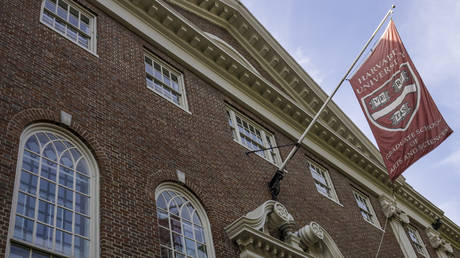 White House halts new grants for Harvard
White House halts new grants for Harvard
US President Donald Trump’s administration is reviewing nearly $9 billion in federal funding for Harvard amid intensive pro-Palestinian protests on campus. Last month, the White House called for changes to governance, hiring and admissions and the elimination of all DEI programs at Harvard in a letter it later claimed was “unauthorized.”
The elite Ivy League university rejected the demands, accusing the White House of attempting to “control” its campus. The university filed a lawsuit over the suspension of approximately $2.3 billion in funding and reaffirmed its commitment to addressing discrimination internally.
READ MORE: Trump team explains letter to Harvard – NYT
In Monday’s letter, Garber said Harvard’s reform efforts were being “undermined and threatened by the federal government’s overreach into the constitutional freedoms of private universities and its continuing disregard of Harvard’s compliance with the law.” He added that the university was pursuing necessary reforms in line with its values and legal obligations.
“But Harvard will not surrender its core, legally-protected principles out of fear of unfounded retaliation by the federal government,” Garber wrote.
Garber also rejected claims of partisanship, adding that he had seen no evidence suggesting international students are “more prone to disruption, violence, or other misconduct” than their peers.
-
Site: southern orders
My blog was the first blog in the world to show Pope Benedict XVI wearing the papal fannon for the first time. My clairvoyance tells me that Pope Leo, in a few years, will recover the fannon too for more solemn papal liturgies.My blog, most humble as it is, through my clairvoyance predicted that Thursday, May 8th would be the day that the new pope would be elected. He was!
On May 8th, as I predicted the election of the new pope, I highlighted that May 8th is the Feast day of the Apparitions of St. Michael the Archangel and that Pope Leo XIII had written the Prayer to St. Michael. Yes, I wrote that before the election of the pope and I suggested that he might take the name Michael. I was wrong about Michael, but more on that later.
I also wrote prior to the pope’s election, that May 8th is also the Feast of Our Lady of the Holy Rosary of Pompeii. After the pope was elected, in his first words to the world, the new pope spoke of Our Lady of Pompeii and then led the world in praying the Hail Mary.
As I mentioned, prior to the pope’s election, I predicted that he might choose the name Michael and I wondered if that would be Pope Michael I as I wasn’t sure if there had been a pope named Michael.
One person who commented on Michael said that there was a schismatic sect in the Church who has a “pope” named Michael and thus he didn’t think the new pope would take that name.
Then another commenter, a convert of mine from St. Joseph in Macon, Georgia, Marc, wrote that the new pope would take the name of Leo XIV! Yes, Marc predicted it and correctly, before the pope was elected, that he would choose the name LEO XIV! I kid you not!
THUS MY BLOG WAS THE FIRST IN THE WORLD BY WAY OF MARC, TO NAME THE NEW POPE’S PAPAL NAME BEFORE THE NEW POPE WAS ELECTED!
Was it intuitive, or does Robert Cardinal Prevost read my blog and did he read what I and Marc predicted about the election of the new pope and what name he would take and the connection to Pope Leo XIII, St. Michael the Archangel and Our Lady of Pompeii as votes were being counted on the day of his election. I doubt that this discreet pope will ever reveal this.
But I do have a feeling, that Pope Leo XIV has read my most humble blog, I really do!
And, in addition to all these phenomenal things coming from my blog as firsts, I was the first to say that we needed to read or interpret Pope Leo XIV through Pope Leo XIII and his social encyclicals. I also indicated that we had to look at Pope Leo the Great (Leo I) to interpret the new pope.
I was the first to write that the new Pope would not cancel Pope Francis but refine his more controversial and seemingly heterodox and cruel decisions.
He would refine TC and make it more like SP, but a refinement of that also.
And now even the heterodox leaning Jesuit Cardinal, Cardinal Hollerich of Luxembourg has said Pope Leo will refine Fiducia Supplicans on blessing actively fornicating lgbtq+++ couples.
I also predicted first that Pope Leo will definitely refine synodality and we will see those refinements and clarity about it very quickly. Pope Leo’s synodality will not undermine the College of Bishops’ divine mandate to teach, rule and sanctify God’s people in union with the pope. Pope Leo’s synodality will promote Catholic unity and purify the divisiveness that Pope Francis’ type of synodality has inflicted upon the Chruch throughout the world.
Pope Leo’s version of synodality will be rooted in the Splendor of Divine Truth as well as Scripture and Tradition and the Magisterium of the Church throughout time.
All this is amazing, so I am told.
-
Site: Mises InstituteAs the progressive left and the anti-trade right merge their arguments, the current political atmosphere is quickly turning into a witch hunt. Unfortunately, we know that these situations don't end well.
-
Site: PaulCraigRoberts.org
Dear Readers, this is one of the most brilliant essays that I have read in recent years. Donald Jeffries explains that the alienation of Western civilization from its heritage has resulted in the replacement of statues of identifiable historic figures, such as Thomas Jefferson, who played a significant role in the origin and development of a new nation, with statues of unidentifiable overweight black women. Thus is American history removed to make room for a fictional history in which we today live. The Democrat liberal-left have created a situation in which Americans no longer know who they are.
Western Civilization Has Been Reduced to a planet of statues of overweight black women. No one else, much less white people, ever trod in the Western World or left any mark.
Recently, there has been a veritable epidemic of statues suddenly popping up all over the globe, depicting overweight Black females. This is decidedly odd, as the figures don’t represent a particular person of historical significance, but rather a modern “Woke” phenomenon of a brand of human being; the loud and proud Black woman.
One of these statues, incredibly enough, was erected in Italy. If anyone can tell me what significance any Black woman has had on Italian history, I’m willing to listen. Maybe the Italians covered up how the Black females in their society- cleverly hidden away from the eyes of the world- have manipulated things behind the scenes for eons. Kind of like an Illuminati of Color. I’m sure Michelangelo and Da Vinci would be proud. Maybe a fat Black woman invented spaghetti. Pizza. Lasagna. Why not? Any African American Studies course worth its salt will tell you how suppressed Black inventors came up with everything from the toaster to the stop light. Lemonade. And most cleverly of all, one magnificent genius invented the comb in the late 1800s. Or centuries after they were depicted in paintings from all over the world. I remember seeing Pocahantas’s comb at the Smithsonian. What a racist to be using a Black man’s invention without giving him credit. Somebody call Elizabeth Warren.
The Italian statue depicts the unknown Person of Color staring down at her cell phone. Surely, this was considered a unique, historical posture. Apparently, there were no available native born Italian girls- overweight or not- who stare robotically down at their cell phones. Not to be left out, the Netherlands put up a statue of a different, but just as insignificant overweight Black woman a few years back in Rotterdam. I guess it’s taken those of us still paying attention a few years to notice. Again, what exactly has any Black woman done to deserve a statue in the Netherlands? Sure, plenty of nonwhites have raped native born residents of the Netherlands, but they were all male and mostly Muslim migrants. They probably have a disproportionate number of Blacks on the Netherlands World Cup soccer team, but I’m not sure what Black women specifically have ever contributed to their society.
In New York City, there is now a twelve foot statue of an obese Black woman- sporting the distinctive hands on hip stance that has made them so beloved in America 2.0. The statue is nonsensically called “Grounded in the Stars.” As someone once said, if you want to gauge the health of a nation, look at its art. The statue provides a startling dose of “diversity,” in contrast to the statues of boring dead White guys Father Francis Duffy and songwriter George M. Cohan. This is the same New York City, of course, who over the past few years took down statues of Teddy Roosevelt and Thomas Jefferson. The message is; an anonymous Black woman is more culturally and historically significant to this country than the most brilliant of our Founding Fathers, who wrote the Declaration of Independence. If that isn’t a slap in the face to the millions who are still asleep, I don’t know what would be.
The first question that should be asked is; why this curious campaign to install statues of fictional Black women? Who started it? Who is behind it? I seriously doubt that leaders in Italy and the Netherlands abruptly determined, independent of each other, that homage should be paid to a demographic group that has zero historical ties to either country. Now, the motivation is obvious. To further promote Black people. Well, any Black people who aren’t questioning the disproportionate power of a certain ethnic/religious group, that is. And to further diminish the historical greatness of formerly hallowed White leaders. And what about the White women? Why doesn’t Pakistan erect a statue of a fictional girl in a bikini? You could have her staring at her cell phone if you want. Nonwhite countries need cultural “diversity,” too, don’t they? Where are the statues of antiwar icon Jeanette Rankin, our greatest historical figure who identified as female?
It’s hard to tell how many Black female statues there are. A few years back, there were reports of them springing up in Roanoke, Virginia, and South Boston. There were already at least six statues of Harriet Tubman scattered across this country. I doubt that there are six statues of White women collectively in America. The most featured female on U.S. statues is the Indian squaw (yeah, I know- that’s probably “hate speech”) Sacagawea, who has an impressive sixteen of them. I guess statues are kind of like presidential candidates; only nonwhite women need apply. And yet White women can’t stop applauding. They may well like fat Black statues even more than transgender athletes. Roanoke, Virginia, which featured Virginia Dare, the first child born in America, vanished without a trace. The city still exists, and despite being on the edge of nearly all-White Appalachia, its only two statues are of Black figures.
The statue of Robert E. Lee that stood in the U.S. Capitol was scheduled to be replaced by a 2021 decree, in favor of a sixteen year old girl named Barbara Johns, who led a student walkout in Prince Edward County in 1951. It was something to do with racism, which they tell us was all the rage back then. One thing you know for sure is that Johns was Black. Virginia has a statue of Mary Todd Lincoln’s Black dressmaker Elizabeth Keckly, but not of Honest Abe’s overly emotional wife. So this explosion of Black female statues is not really new. They were already overrepresented. As one typically absurd “Woke” spokesperson put it, this is an effort to “confront preconceived notions of identity and representation.” It’s inevitable that one or more statues of Black women with suitably fat asses will pop up somewhere, to memorialize the fine art of twerking. We would not want future generations to forget that.
This well organized campaign comes on the heels of laughable propaganda that “Black women built this country.” What? I can’t think of any group that had less to do with building this country. Well, maybe Hispanics. After all, they weren’t here then. The very term had yet to be invented. Or Muslims. No, it was almost exclusively White males who built this country, backed by hearty and supportive frontier wives, mothers, and daughters. But it’s “racist” to even say that. And on top of that, there is the even more head shaking “Shut up! A Black woman is speaking!” This ridiculous expression is parroted most enthusiastically by self-loathing White women. This kind of insidious programming goes well beyond conventional Stockholm Syndrome. White women are not literally being held captive by Black women. This is just one of the reasons why I maintain at least 1/3 of White women today are clinically insane.
If they expand their horizons, there are plenty of worthy flesh and blood candidates to consider. Queen Latifah is certainly fat enough, and at least has displayed her lack of acting skills in a good number of IMDB credits. Stacy Abrams? She lost an election and is still complaining about it. And I don’t have to tell you that they don’t come any obesier in the Black community than her. Oprah? Imagine how excited the White women would be! Their “girlfriend,” who manipulated them to high ratings, and then dropped their racial and sexual comrade Hillary like a hot potato when Barack Obama declared for the presidency. It would take some skill to get the majesty and scope of Oprah’s giant behind just right, kind of like the Venus de Milo from a dark universe. And if you want to be inclusive of non-obese Black women, there’s Kamala. Perhaps Jasmine Crockett. And Michelle Obama can represent….well, you know.
If this isn’t some kind of fractured, black humor (no pun intended), then what is it? No one can seriously suggest that we should be putting up statues of random unknown figures, who have accomplished nothing to be remembered for. I don’t want statues of hot naked fictional women showing up everywhere, either, with or without cell phones. This is Identity Politics writ large, on the world stage. Black men are promoted incessantly by the same usual suspects, but it is the Black woman who reigns supreme in America 2.0. Who gets to rake in millions with little or no qualifications, while skewering the English language. I’m not sure which is worse; not being recognized for great accomplishments, or being credited undeservedly for imaginary achievements. Obviously, too many Black women fall into the later category. I can hear them screaming “Excuse me!” as they read this.
Why not honor a strong Black woman who has done noteworthy things? I’m talking about my friend, ex-congresswoman Cynthia McKinney. She wrote blurbs for me, and honored me by asking me to write a blurb for her provocatively titled book How the US Creates Sh*thole Countries. McKinney had the courage no one else in Congress did, grilling Donald Rumsfeld about the $2.3 trillion missing from the Pentagon. Oh well, DOGE will probably find that and much more. They are still planning to audit the Pentagon, right? McKinney also stated that members of Congress are asked to sign an oath of loyalty to Israel, which she refused to do. McKinney suddenly started looking a lot less Black, and was quickly ousted from Congress. She’s a truly open minded, insightful individual, my favorite politician. Imagine being relegated from serving in Congress to communicating with the likes of Thought Criminals like me.
It’s odd that these dubious new statues come in the wake of all those which were torn down a few years ago by angry Black Lives Matter protesters. Sort of gives new meaning to the term “Great Replacement.” The “Woke” authoritarians are dancing a politically correct line between censoring any references to certain historical figures, and perpetually blasting them as racist. As I have said for years, at some point history itself will be declared racist. Maybe it already has been, and I missed it. And why not? Math is, as well as proper English. I’ve been lectured about how free speech is racist. Perhaps in the ultimate irony, freedom itself is racist. The slavery that entraps some 40 million people around the world today apparently isn’t racist enough to attract much condemnation. Brown people enslaving other Brown people can’t be virtue signaled. Apparently, all slave lives don’t matter.
Statues used to be exclusively for dead historical figures. Those obese Black women aren’t dead. To be fair, being fictitious, they aren’t really alive, either. A few years ago, the mayor of New Orleans unleashed a new statue, in honor of the ridiculous “Woke” holiday Juneteenth. It consisted of a giant Afro hair pick, with an upraised “Black Power” fist. I don’t know, but if I was Black, I think I’d be really offended by that. I mean, not that many Blacks even have Afros now, and that’s how you choose to honor them? For having kinky hair? I wouldn’t object to that memorial being called racist. This was New Orleans; how about a statue of Louis Armstrong? Do Black people see themselves as giant Afro picks? If that’s the case, maybe having some unreasonably proud fat Black women look appropriately combative makes sense. If only AI could get that neck bobbing thing down, then they’d really have some statues.
This is really a logical extension of promoting ugly art and declaring it beautiful. We now know that the CIA was financing putrid “artists” like Jackson Pollock, and convinced the always malleable public that glorified finger painting was “modern art.” What do you see in that square? Just a completely devious agenda to destroy a culture. And they succeeded. Where are the real artists today? The ones that can do better than giant Afro picks and fat Black women? If we were to judge our civilization by its present art, we’d have to say we are no longer civilized. The same goes for architecture; aesthetically unpleasing, ugly eyesores littering the landscape. How could they have built far more beautiful buildings centuries ago? Why are we devolving in every aspect of our culture? When you don’t believe in God, there is no spiritual element in your art. The divine spark is what makes it special.
It’s not enjoyable to take these kinds of stances, which are instantaneously condemned as “racist.” But someone has to. Thankfully, these fat Black statues are fully dressed, but in a figurative sense, they aren’t wearing any clothes. I’m like the little boy in the fairy tale who points that out to the clueless and/or frightened crowd. Just how brainwashed do you have to be to want to excessively celebrate the contributions of the loudest, most arrogant, and least educated members of your society? What next- a memorial to them destroying a Popeye’s because they ran out of hot sauce? My observations are all based on reality, not propaganda. I don’t want Black women treated unfairly. I just don’t want them to be irrationally adored. Let’s laud the guy working two jobs to make ends meet. The mother struggling to raise six kids on a shoestring budget. Not an arrogant narcissist in love with herself.
-
Site: Zero HedgeChina Reverses Ban On Boeing Jet Deliveries After Trade Breakthrough With USTyler Durden Tue, 05/13/2025 - 07:20
China lifted a month-long ban on Boeing jet deliveries for all domestic carriers just one day after a breakthrough in U.S.-China trade talks, Bloomberg reports, citing people familiar with the matter.
Chinese officials instructed domestic carriers and government agencies at the start of the week that deliveries of US-made jets were allowed to resume. This decision coincides with a 90-day tariff truce, during which the U.S. slashed tariffs on Chinese imports from 145% to 30%, and China cut import duties on US goods from 125% to 10%.
In April, the tit-for-tat trade war between the Trump administration and China led to Beijing's non-tariff countermeasures, including Juneyao Airlines that delayed the delivery of a 787-9 Dreamliner.
Last week, ahead of U.S. Treasury Secretary Scott Bessent's weekend meeting with Chinese counterparts for the first round of trade talks in Switzerland, a Bloomberg report specified that China Airlines placed an order for more than a dozen 777 planes. At the time, we asked if this was a "goodwill gesture" by Beijing ahead of the trade talks.
Trade talks have since de-escalated the tariff war.
Still, Goldman expects the overall effective tariff rate in the U.S. to be around 15% - a generational high dating back to the 1930s.
China's move to resume Boeing deliveries may provide a short-term boost for the sideways pattern shares have traded in for five years. Premarket activity in New York shows shares are up nearly 1%, trading around the $200 handle. Year-to-date, shares are up 12% as of Monday's close.
Great news for Boeing.
-
Site: Rorate CaeliFriends of CAMPOS, BRAZIL: EASTERTIDE Easter appeal a {text-decoration: none;} 96 .rollover:hover .New Catholichttp://www.blogger.com/profile/04118576661605931910noreply@blogger.com
-
Site: RT - News
Steve Witkoff has called efforts to isolate the Russian president counterproductive for resolving the Ukraine conflict
Isolating Russian President Vladimir Putin is unlikely to help resolve the Ukraine conflict, senior US negotiator Steve Witkoff has said, calling the approach lacking in logic.
Western nations have attempted to marginalize Moscow diplomatically since the escalation of the conflict in 2022, but Witkoff, speaking to Breitbart News last week, criticized that approach. He emphasized the necessity of including all major players in the dialogue.
”We need to talk to any stakeholders in this conflict,” Witkoff said in the section of the interview published Monday. “There is no deal without President Putin’s sign-off.” US President Donald Trump’s special envoy added that he found it difficult to “understand the logic” of those who oppose direct engagement with the Russian leader.
The Trump administration’s current stance is that Russian and Ukrainian officials must be brought together physically so that the US can “show them that the alternatives to a peaceful resolution here are bad for everybody.”
Read more Western Europe’s efforts a ‘complete fiasco’ – Moscow
Western Europe’s efforts a ‘complete fiasco’ – Moscow
The Trump administration’s current stance is that Russian and Ukrainian officials must be brought together physically so that the United States can “show them that the alternatives to a peaceful resolution here are bad for everybody.”
Putin last week reiterated Moscow’s call to resume negotiations that Kiev abandoned in 2022, proposing that talks be held again in Istanbul. Ukraine’s Vladimir Zelensky and several European NATO members have insisted that Russia first agree to an unconditional 30-day ceasefire, warning that failure to do so will result in further sanctions. Russian officials say such a pause would give Kiev an opportunity to regroup militarily and renew hostilities.
Putin has offered to restart negotiations as early as Thursday. Zelensky has said he will go to Istanbul that day and expects Putin to come too.
Witkoff emphasized that the US could step back from its mediating role if progress is not made. “The president has issued an ultimatum to both sides” to begin direct talks, he said.
”I think if the US pulls back from this conflict… that’s a bad result for everybody,” he added. “It’s bad for the Europeans. It’s bad for the Ukrainians. I don’t think it’s good for the Russians. I think the Russians actually do want a peaceful settlement.”
READ MORE: Top Russian MP tells Zelensky to ‘stop the clownery’ (VIDEO)
Moscow has urged a comprehensive agreement that addresses what it sees as the root causes of the conflict, including a promise by NATO to eventually admit Ukraine and discriminatory policies by Kiev toward ethnic Russians.
-
Site: Zero HedgeTaliban Bans Chess In Afghanistan: 'Means Of Gambling'Tyler Durden Tue, 05/13/2025 - 06:55
We weren't aware that the game of chess could lead to a raging gambling addiction, but apparently the Taliban thinks so...
"The Taliban government in Afghanistan has banned chess until further notice due to fears the game is a source of gambling," BBC reports Monday. "Officials said the game has been prohibited indefinitely until its compatibility with Islamic law can be determined."
"There are religious considerations regarding the sport of chess," Atal Mashwani, the spokesman of the Taliban government's sports directorate, told AFP news agency. "Until these considerations are addressed, the sport of chess is suspended in Afghanistan."
 Via AFP
Via AFP
He explained that chess in Islamic sharia law is "considered a means of gambling" - but didn't explain further on how this might be so.
It is but the latest absurd, draconian move by Taliban authorities since seizing power again in August 2021, following a more than two decade war with occupying US-NATO forces.
Some cafe owners have been quoted in Western media reports as describing chess as one of the few positive and healthy activities young people in the country can engage in.
But with many sports and intellectual activities also restricted and deemed 'unIslamic' - there are fewer and fewer games and hobbies the population has access to, also amid ongoing economic collapse and suffering.
"Chess has been gaining popularity in Afghanistan in recent years, according to Khaama Press," Russia's TASS notes. "A few days before it became known about the ban, a group of activists has asked the government for funding to develop chess in the country."
According to a historical outline from Chess.com:
The Taliban had also banned chess soon after coming into power in Afghanistan in 1996, but the game returned as a popular pastime in the country after the regime change in 2001. At the Batumi Olympiad in 2018, Afghanistan won the D Category with CM Khaiber Farazi, CM Habibullah Amini, Wais Abdul Khaliq, Ashrafi Sulaiman Ahmad, and Safy Kanz Ahmad in the team. The Taliban retook control of the country in 2021 and has now announced the suspension.
But many Islamic countries and populations across the Mideast region routinely send chess players to international competitions and events. The Taliban has once again set itself apart as the 'most extreme' government in the region and the world.
Certainly, this 'pause' which is likely to lead to a more permanent ban on playing chess in Afghanistan won't help the Taliban's chances of getting international sanctions against it lifted.
‼️ In connection with the situation with the ban on chess in Afghanistan, I have prepared an appeal to the Taliban leadership with a request to reconsider their decision. pic.twitter.com/pP7qojbLJ6
— Кирсан Илюмжинов (@Kirsan__) May 11, 2025The war-ravaged country's pre-Taliban population, for example back in the 1970s, was actually somewhat liberal, cosmopolitan and open - with women regularly wearing European fashions, and Islamic garb was rarely seen in the cities.
All of that changed with the CIA's Operation Cyclone, which saw American and allied operatives (such as in Pakistan's ISI) arm, train, and equip radical Afghan and Arab mujahideen. These militants would later form the core of the Taliban and its terror allies.
-
Site: Zero HedgeFBI Deputy Director Says Illegal Immigrant Criminals, Child Predators Are Top PriorityTyler Durden Tue, 05/13/2025 - 06:30
Authored by Jack Phillips via The Epoch Times (emphasis ours),
The FBI is prioritizing removing illegal immigrants with criminal records and arresting child predators, the deputy director said on May 10.
 An FBI agent walks toward a crime scene, in this file photo. Mario Tama/Getty Images
An FBI agent walks toward a crime scene, in this file photo. Mario Tama/Getty Images
“[The FBI] workforce has been working overtime on task force operations to remove dangerous illegal aliens from the country. The work continues,” FBI Deputy Director Dan Bongino, a former radio host, wrote in a lengthy post on social media platform X.
“If you came here illegally to prey on our citizens, your days here are numbered.”
Such efforts are likely to ramp up in the coming weeks, Bongino said in the post, which he described as an operational update. He also said the agency is increasing enforcement against individuals who prey on children.
“Crimes against children are a priority for the workforce. Operation ‘Restoring Justice,’ where we locked up child predators and 764 subjects, in every part of the country, is just the beginning,” he said, referring to a recent operation announced by the FBI.
“We are going to take your freedom if you take away a child’s innocence.”
Hundreds of suspected child predators were arrested over a five-day period, and 115 children were rescued, the FBI and Department of Justice (DOJ) announced on May 7.
Elsewhere in his post, Bongino said that the bureau would provide regular updates to Congress and is responding to high-profile cases that arose in recent years. These include the shooting at a congressional baseball game in 2017 that left Rep. Steve Scalise (R-La.) gravely injured, the 2023 Christian school shooting in Nashville, Crossfire Hurricane, the origins of COVID-19, and the release of files related to sex trafficker Jeffrey Epstein.
“There are voluminous amounts of downloaded child sexual abuse material that we are dealing with,” Bongino wrote in addressing the Epstein case. “There are also victims’ statements that are entitled to specific protections. We need to do this correctly, but I do understand the public’s desire to get the information out there.”
He also said that the FBI is doing its “best in the current budgetary environment to prioritize the mission, act as good fiscal stewards, find waste and inefficiencies, and to enact reforms while moving the FBI forward.”
FBI Director Kash Patel told Congress on May 8 that he would make the bureau’s mission “work on whatever budget we’re given,” a day after he said that he was seeking more funds than what the Trump administration had proposed.
The 2026 budget proposal released in early May calls for a funding cut of about $545 million for the FBI as part of what the White House said was a desire to “reform and streamline” the bureau and reduce “non-law enforcement missions that do not align” with President Donald Trump’s priorities.
“My view is that we agree with this budget as it stands and [will] make it work for the operational necessity of the FBI, and as the head of the FBI, I was simply asking for more funds because I can do more with more money,” Patel said in a Senate hearing.
The Associated Press contributed to this report.
-
Site: Zero HedgeUS Treasury Shocks With Second Biggest Budget Surplus In HistoryTyler Durden Tue, 05/13/2025 - 06:01
Two weeks ago, as part of its quarterly refunding announcement, the Treasury surprised the market when it unveiled a funding need for the current quarter that was $53 billion lower than it had initially forecast in February, and which we said "indicates that DOGE is indeed working and the US funding needs are actually declining."
Needless to say, for a market that was habituated to Joe Biden's debt-funded drunken sailor spending ways, the news that the US would needs less - not more - spending than previously expected, came as a shock, and yields slumped as less debt than expected would be required to fund the world's most indebted government.
Today we got the reason why the borrowing need of the US was surprisingly lower than previously expected, and it was revealed in the latest Treasury Monthly Statement laying out the US government's monthly deficit... or rather surplus. Yes, we are so used to describing the sum-total of the US government's monthly income statement as a deficit (i.e., more spending than revenue) that it has become automatic to assume that every month the US will spend more than it brings in. Only this time that wasn't the case.
Presenting Exhibit A: in April, the US Treasury generated a $258.4 billion surplus after last month's $160.5 billion deficit; this the second biggest surplus on record, with just the $308 billion bumper surplus in 2021 bigger.
To be sure, while US surpluses are few and far between, the one time of the year when they can (occasionally) be seen, is in April, when a surge in tax income offsets the now chronic government bloat and spending. This April was just that, and while the US did spend a hefty $592 billion in April (slightly more than the $528 billion in March, and more than the $567 billion spent a year ago) of which very ominously more than $100 billion was gross interest on the record US debt (which at this moment is about $37 trillion) for the second month in a row...
... the revenue collected by the US treasury managed to more than offset this massive spend, and surged by a whopping $850 billion, just shy of the record $864 billion record in April 2022.
The unexpected surge in revenue, and the resulting budget surplus means that the cumulative deficit for fiscal 2025 suddenly doesn't look catastrophic: recall that just four months ago, back in January, in the last month of Biden's reign, the US had already spent a record $840 billion for the first 4 months of the year, on pace to blow away all previous records. But then something changed, and first March saw a big slowdown in spending which resulted in a much more tame cumulative deficit through March, and then the April data meant that the cumulative deficit in the first seven months of the year, was actually an improvement, and dropped to just $1049 billion, down from a peak of $1037 billion in March, and below the run-rate of both 2021 and 2024.
And while the primary reason for the unexpected budget surplus was a far bigger tax haul than expected, mostly thanks to a burst in capital gains tax which is unlikely to be repeated this year (unless we see the S&P rise another 20% from here by year end), there was another big reason for the April revenue surge, a reason we profiled previously in "Trump Trade War Results In Record $12 Billion Surge In Customs Revenues." As shown in the chart below, Customs Duties in April doubled from $8.2 billion in March to a record $15.6 billion in April, thanks to surge in Trump tariffs.
And while all of that is a good start, and certainly a big improvement in the US fiscal picture in the first three months of Trump's regime, the big picture sadly remains a dismal one, largely because the US debt picture remains completely unsustainable and manifests itself in $1.2 trillion in gross interest expense per year, just $300 billion shy of the biggest spending category of them all: Social Security Spending.
That said, April's bumper revenue aside, all five main spending categories are growing much faster than revenue, and something drastically has to change for this big picture to become viable. Unfortunately, we have now seen the wholsesale pushback Trump has faced when doing just that - trying to restructure a broken status quo - which is why unless Trump magically succeeds in this undertaking, the US is pretty much doomed (while DOGE's achievements have been admirable, they are a drop in the bucket in the context of Congresionally appropriate spending) as nobody else will ever come close to Trump's intended overhaul of the US fiscal picture.
-
Site: Real Investment Advice
Despite the weekend's positive news on China trade negotiations and the associated jump in most stock prices, the healthcare sector was hit hard. The culprit is an executive order aimed at reducing U.S. prescription drug prices. Donald Trump plans to implement a "Most Favored Nation" (MFN) policy. The policy would tie Medicare drug prices to the lowest prices paid by other countries. Consequently, drug prices in the US could fall an estimated 30% to 80%. Or, they could rise substantially abroad.
While daunting for the healthcare industry at first glance, the executive order faces significant challenges. The industry has long argued that such a policy stifles innovation and reduces R&D. Moreover, the courts could present a significant roadblock. Courts blocked a similar proposal by Trump in 2020. Also worth noting is that the order's specifics, such as which drugs and insurance programs it will cover, remain unclear. Additionally, its implementation may require congressional action.
The pharmaceutical lobby is strong. As we share below, courtesy of Statista, pharmaceutical and health product companies spend significantly more on lobbying than other industries. They will put undue pressure on Congress and likely minimize the executive order's impact.

What To Watch Today
Earnings
- No notable earnings releases today
Economy

Market Trading Update
Yesterday, the market rallied sharply following news that a trade negotiation had been struck with China, reducing tariffs to just 30% over the next 90 days. Technically, we continue to track the initial decline and rally in 2022. As I stated previously, I don't like analogs as "this time is always different," however, it is worth noting that bear market rallies look like the end of corrections and a return of a bull market, until it isn't.

From a technical perspective, the market also continues to trace the reversal of extremely oversold conditions to more optimistic ones.

As noted in Monday's Trading Update, this could still be a "bear market rally," as we saw in 2022. Such is entirely possible. But with the markets breaking above both resistance levels at the 100 and 200 DMA, there is a rising probability that the correction process is over. With the MACD pushing more elevated levels and the RSI index approaching overbought, we are at levels where we should expect a "pause" in the rally before making the next push higher. If the market can consolidate a bit, without breaking back below those previous resistance levels, we will remove hedges and reduce our cash holdings.

However, this week we will have the next batch of economic data, including CPI, which will likely determine the market's next move. We remain somewhat cautious with our allocations, but the market reversal is healthy. We are watching our weekly indicators closely, and if they turn back to the positive, we will look to overweight equities and reduce cash holdings completely. However, that will likely be several weeks before seeing those signals turn.
Trade accordingly.

Industrials And Healthcare Move In Opposite Directions
As shown below, courtesy of SimpleVisor, the impact of potential tariffs plays a significant role in stock sector selection. With news of tariff agreements, the industrial and technology sectors, both among the most negatively impacted by tariffs, are now the most overbought on a relative basis. Healthcare, which has traded poorly on rumors of executive actions calling for lower drug prices, weighs on healthcare stocks. The sector will be pushed further into oversold status over the coming days as Trump's prescription pricing plan was announced on Sunday.
The graph to the right of the sector scores shows that both healthcare and industrials were orbiting around in the upper left box, denoting decent relative scores versus the market but oversold on an absolute basis. Over the last two weeks, industrials moved to the upper right and healthcare to the lower left. The second graphic shows that aerospace companies are leading the industrials sector.


A Bear Market Rally, Or Just A Correction?
Assessing a bear market rally proves challenging when you experience it firsthand. It is only in hindsight that the complete picture reveals itself to investors. Of course, after a bear market rally, investors tend to review their investments and speculate on what they should have done differently.
Retail investors seem to view the recent sharp correction as possibly finished. As I noted last week on X, despite the near 20% correction in the markets, retail investors piled into US equities at a record pace. Of course, historically, retail investors were considered a contrarian indicator, but in recent years, particularly post-pandemic, they have been aggressive buyers of any dip in the market. Of course, after 15 years of monetary and fiscal interventions to stave off deeper bear markets, their “buy the dip” mentality is unsurprising.

Tweet of the Day

“Want to achieve better long-term success in managing your portfolio? Here are our 15-trading rules for managing market risks.”
Please subscribe to the daily commentary to receive these updates every morning before the opening bell.
If you found this blog useful, please send it to someone else, share it on social media, or contact us to set up a meeting.
The post Executive Order On Drug Prices Rattles Healthcare Sector appeared first on RIA.
-
Site: Zero HedgeThese Are America's Fastest-Growing CountiesTyler Durden Tue, 05/13/2025 - 05:45
On average, U.S. counties grew by 1,000 people from 2023 to 2024.
But the level of population growth varied widely from place to place.
This chart, via Visual Capitalist's Jenna Ross, in partnership with BGO, shows the fastest-growing counties.
Ranking the Largest Population Increases in U.S. Counties
Using the latest data available from the U.S. Census Bureau, here are the counties that had the largest population growth measured in number of people.
Rank County 2023-2024 Population Change,
Number of People 1 Harris County, Texas 105,852 2 Miami-Dade County, Florida 64,211 3 Maricopa County, Arizona 57,471 4 Collin County, Texas 46,694 5 Clark County, Nevada 44,586 6 King County, Washington 43,398 7 Cook County, Illinois 40,095 8 Broward County, Florida 34,686 9 Montgomery County, Texas 34,268 10 Tarrant County, Texas 32,793 11 Orange County, Florida 32,381 12 Denton County, Texas 31,384 13 Fort Bend County, Texas 31,314 14 Mecklenburg County, North Carolina 30,057 15 Bexar County, Texas 29,548 16 Santa Clara County, California 29,188 17 Wake County, North Carolina 29,050 18 Polk County, Florida 28,706 19 Pinal County, Arizona 27,467 20 New York County, New York 27,435 21 Riverside County, California 26,384 22 Williamson County, Texas 25,840 23 Los Angeles County, California 25,342 24 Kings County, New York 24,694 25 Palm Beach County, Florida 24,574Harris County, which includes Houston and neighboring communities, had by far the biggest population growth. The primary driver of the county’s growth was international migration. On a domestic basis, more U.S. residents moved out of Harris County than those that moved into the area.
While international migration was the biggest contributor to population growth in most areas, some counties bucked the trend. Domestic migration drove the bulk of population growth in Montgomery County, Denton County, and Williamson County in Texas, along with Polk County, Florida and Pinal County, Arizona.
The only county on the list to see a bigger boost from the natural change in population (births minus deaths) compared to net migration was Kings County, New York.
Preparing for Larger Populations
In general, population growth was concentrated in counties that already had large populations. One challenge of growing populations can be ensuring there is sufficient housing for all of the new residents.
To meet rising demand, BGO is expanding its investment in high-quality multi-family and build-to-rent communities across fast-growing Sunbelt and Western U.S. markets. This includes Phoenix in Maricopa County—now the third fastest-growing county in the country—as well as residential properties in other population growth hubs like Miami-Dade and King County.
-
Site: LES FEMMES - THE TRUTH
-
Site: Real Investment Advice
Risk management is one of the most crucial elements of successful financial planning, serving as the foundation for both protecting your assets and achieving your long-term financial goals. Whether you're in the early stages of building wealth or actively preparing for retirement, the ability to anticipate, understand, and navigate financial risks is vital to maintaining stability and peace of mind.
From market volatility and rising interest rates to unexpected health expenses and the risk of outliving your savings, every stage of life presents unique challenges that can impact your financial well-being. Proactive risk management helps ensure that your financial plan remains resilient in the face of uncertainty—minimizing losses, preserving gains, and allowing for steady progress toward your goals.
This guide outlines the most common financial risks individuals and families may encounter and offers practical, proven strategies to mitigate them. Whether you're a seasoned investor or just beginning to map out your future, understanding how to manage risk is essential to making informed decisions and securing your financial future with confidence.
Understanding the Different Types of Financial Risk
Effective risk management begins with understanding the various threats to your wealth:
Market Risk
Market risk refers to the possibility that investments will lose value due to fluctuations in the financial markets. Stock prices, for example, can be impacted by economic events, political developments, or investor sentiment. This type of risk can affect both equity and bond investments.
Interest Rate Risk
Interest rate risk affects bondholders primarily. When interest rates rise, existing bond prices typically fall, which can negatively impact your portfolio. This risk is particularly relevant in today’s rising rate environment.
Longevity Risk
Longevity risk is the possibility of outliving your savings. As life expectancy increases, so does the need for a retirement plan that accounts for decades of income needs.
Inflation Risk
Inflation erodes the purchasing power of money over time. If your investments don’t keep pace with inflation, your real returns may be significantly reduced.
Liquidity Risk
This is the risk of not being able to access your money when you need it. Certain investments—like real estate or some annuities—are less liquid than others and can restrict your flexibility during financial emergencies.
Strategies to Mitigate Investment and Retirement Risks
Managing financial risk doesn’t mean avoiding risk altogether. Instead, it involves building a portfolio that balances potential returns with your ability to withstand loss.
Diversification
Spreading investments across various asset classes—stocks, bonds, real estate, and alternatives—can reduce your exposure to any single source of risk. A well-diversified portfolio can help cushion the impact of a downturn in one sector.
Asset Allocation
Your investment mix should reflect your time horizon, risk tolerance, and retirement goals. Younger investors may lean more heavily toward equities for growth, while those approaching or in retirement should consider shifting toward income-generating and lower-volatility assets.
Rebalancing
Over time, market movements can skew your asset allocation. Regular rebalancing brings your portfolio back in line with your original risk tolerance and investment objectives.
Hedging Techniques
Sophisticated investors may use hedging strategies like options, futures, or inverse ETFs to protect against losses. While these tools aren’t right for everyone, they can serve as a buffer during periods of extreme market volatility.
Using Insurance to Manage Risk
When it comes to preserving long-term financial stability, insurance is one of the most powerful—and often underutilized—tools in a comprehensive risk management strategy. While investments focus on growing wealth, insurance is designed to safeguard it. Life is full of unpredictable events that can disrupt your income, drain your savings, or place a financial burden on your loved ones. Insurance helps offset these risks by providing protection against significant losses that could derail your financial goals.
Whether you're in your prime earning years, approaching retirement, or already enjoying life post-career, incorporating the right insurance coverage into your financial plan is essential. It allows you to navigate the unexpected with greater confidence and ensures that your overall strategy stays on track, even when life throws a curveball.
Life Insurance
Life insurance offers critical financial protection for your loved ones in the event of your death. It can replace lost income, cover outstanding debts, or provide funds for future expenses such as college tuition. For high-net-worth individuals, life insurance also plays a key role in legacy planning and can provide liquidity to cover estate taxes, allowing heirs to retain valuable assets without forced sales.
Health and Long-Term Care Insurance
Healthcare costs are one of the most significant financial risks in retirement. Without adequate coverage, a serious illness or need for long-term care can rapidly deplete even a well-funded portfolio. Health insurance helps cover routine and unexpected medical expenses, while long-term care insurance helps protect against the high costs associated with assisted living, nursing homes, or in-home care services—expenses that Medicare doesn’t always cover.
Disability Insurance
For those still in their working years, your ability to earn an income is your most valuable asset. Disability insurance provides a safety net if illness or injury prevents you from working. It ensures that your financial goals don’t come to a halt just because your income stream does. Short-term and long-term disability policies can replace a significant portion of your income, allowing you to maintain financial stability during recovery.
Insurance is not just a safety net—it’s a strategic component of any well-rounded financial plan. It provides peace of mind, knowing that you and your family are protected against life’s uncertainties. By evaluating your needs at every stage of life and securing the right combination of life, health, long-term care, and disability insurance, you can ensure that your financial future remains intact, even in the face of the unexpected.
Incorporating Guaranteed Income Products
To mitigate longevity risk and provide predictable income, many retirees turn to guaranteed income products.
Annuities
Annuities are financial products designed to provide a stream of income, often for life—making them a valuable component of retirement income planning. In essence, they act like a personal pension, offering guaranteed payments that can help ensure you don’t outlive your savings. Annuities can be especially useful for those seeking predictable income in retirement or looking to reduce reliance on market-based withdrawals.
There are several types of annuities, each offering unique features based on your financial goals and risk tolerance:
- Fixed Annuities: These provide consistent, guaranteed payments for a set period or for life. They are ideal for conservative investors seeking stability and reliability.
- Variable Annuities: With this type, payments fluctuate based on the performance of underlying investment options. While they offer the potential for higher returns, they also carry greater risk and fees.
- Indexed Annuities: These annuities are tied to the performance of a specific market index (such as the S&P 500). They offer a balance between growth potential and security, with built-in downside protection that typically limits losses in down markets.
While annuities can be a powerful tool for creating lifetime income, they’re not right for everyone. It’s important to evaluate fees, liquidity restrictions, and your overall retirement strategy before purchasing an annuity. A financial advisor can help you determine if and how annuities fit into your long-term plan.
Stress Testing Your Financial Plan
Even the most carefully constructed financial plan should be tested against worst-case scenarios. Stress testing evaluates how your plan would perform under different conditions, such as:
- A prolonged market downturn
- A major health crisis
- Inflation spikes
- Early retirement due to job loss
By identifying vulnerabilities, you and your financial advisor can make adjustments in advance and avoid reactionary decisions during periods of uncertainty.
Why Risk Management Matters More in Retirement
Once you’ve retired, your ability to recover from losses is limited. Without a regular paycheck to replenish your portfolio, protecting what you’ve accumulated becomes a top priority. That’s why retirement risk planning isn’t just about asset allocation—it’s about building a financial safety net for the unexpected.
Need help building a risk-resilient plan?
At RIA Advisors, we specialize in investment risk management and retirement risk planning tailored to your unique goals. Whether you’re in the accumulation phase or already in retirement, we’ll help you prepare for the road ahead with clarity and confidence. Contact us today to schedule your consultation.
FAQs
What is the most common financial risk in retirement?
Market risk and longevity risk are among the most common. Market downturns can erode portfolio value, while longevity risk increases the need for a sustainable income plan.
How can I protect against outliving my savings?
Incorporating annuities, managing withdrawal rates, and maintaining a diversified income strategy can help ensure you don’t outlive your retirement savings.
Are annuities a good option for managing retirement risk?
Annuities can provide guaranteed income, which helps reduce longevity and market risks. However, they come with trade-offs like fees and limited liquidity.
What role does insurance play in investment risk management?
Insurance helps protect your wealth against unexpected events such as illness, death, or disability, which can otherwise derail your financial plan.
Should I adjust my investment risk as I age?
Yes. As you approach retirement, it’s wise to shift toward more conservative, income-generating investments to preserve capital and reduce volatility.
The post The Essential Guide to Risk Management in Investment and Retirement Planning appeared first on RIA.
-
Site: AsiaNews.itThe country holds vast potential for the development of solar energy, yet it is still in the early stages of this journey. As a result, to heat water for tea, people often have to light a coal fire while waiting for a bit of electricity to arrive — electricity that is still rationed to just a few hours a day, especially during the winter.
-
Site: AsiaNews.itToday's news: Former Philippine President Duterte elected mayor of Davao despite being held in The Hague;Prime Minister Modi gives first public address after clashes with Pakistan;Australia to pursue rare earth trade deals with Indonesia;US President Donald Trump arrives in the Gulf after suspending tariffs with China.
-
Site: Crisis Magazine

As the cardinal proto-deacon concluded the announcement of the new pope, 69-year-old Cardinal Robert Francis Prevost stepped onto the loggia of St. Peter’s Basilica. He wore a white cassock, a white zucchetto, a red pellegrina, a red-and-gold stole, and a pectoral cross. He had chosen the name Leo XIV. Many were surprised by the election of another pope from the Americas—especially from the United…
-
Site: Crisis Magazine

Congratulatory messages to Pope Leo XIV were issued by world leaders of Catholic and non-Catholic nations alike on his elevation to the Throne of St. Peter. Even Russian President Vladimir Putin offered his “cordial congratulations,” saying, “I am confident that the constructive dialogue and cooperation between Russia and the Vatican will continue to flourish, grounded in the shared Christian…
-
Site: Zero HedgeNet Deadly: Europe's Blackouts Are A Warning For AmericansTyler Durden Tue, 05/13/2025 - 05:00
Authored by Jonathan Miltimore via the Washington Examiner,
A massive blackout crippled Spain and Portugal on Monday, April 28, grounding flights, halting transport, and leaving millions without power.
The cause was “unclear,” the New York Times reported, with “no evidence of a cyberattack.”
As Spanish officials urged citizens to stay off the roads, European leaders said they were attempting to ascertain the cause of the mysterious outage.
“We do not yet have conclusive information on the reasons for this [power] cut,” Spain’s Prime Minister, Pedro Sanchez, said in a national address.
On Tuesday, April 29, power was largely restored, but the Associated Press reported that the blackouts “remain a mystery.”
Some pundits, however, observed a remarkable coincidence in the timing of the blackouts.
“Six days ago, the media celebrated a significant milestone,” Michael Shellenberger observed on Substack.
“Spain’s national grid operated entirely on renewable energy for the first time during a weekday.”
Shellenberger was not the only person to claim that Europe’s overreliance on intermittent sources such as wind and solar had left its energy grid vulnerable.
“I would say there’s a strong chance that the large amount of solar on the system created the conditions for this to be a widespread blackout and made it much worse,” said Kathryn Porter, an independent energy consultant.
Many saw this tragedy coming.
European lawmakers’ infatuation with “green” energy, which is not as green as its supporters would have you believe, has been causing problems on the continent. Energy prices have soared in recent years. As the average household electricity bill skyrocketed, many nations scrapped energy taxes to help struggling (and angry) consumers.
In their rush to go green, many countries (including Spain) over the last decade began to phase out not only fossil fuels but nuclear power.
A tightening energy supply was exacerbated by the outbreak of the Ukraine War. Facing a full-blown energy crisis, governments began imposing regulations that forced Europeans into more Spartan lifestyles.
Energy rationing, including limits on hot showers and swimming pools, fueled public anger and helped trigger the 2024 “greenlash,” as Green parties were routed across Europe.
Spain and Portugal were among the nations that resorted to energy rationing. A European Union agreement tailored specifically for these nations was approved by lawmakers despite opposition from some regional authorities.
The law, among other things, set temperature limits for public and commercial buildings (no lower than 80°F for cooling, no higher than 66°F for heating), required “energy-efficient” appliances, and accelerated renewable energy projects. Meanwhile, the law was accompanied by a plan to cut 13.5 percent of domestic gas for power generation.
These actions didn’t happen in a vacuum. It was all part of Spain’s plan to achieve net-zero emissions by 2050.
Net zero was always a pipe dream, but it was a lucrative one for politicians and their allies. Under the banner of fighting climate change, lawmakers funneled billions of dollars into subsidies, grants, and contracts that enriched a network of special interests, including renewable energy companies, consulting firms, and financial institutions.
The climate ring is now collapsing, but the costs of the experiment are visible. Europe’s energy infrastructure has languished and is in dire need of investment. Meanwhile, historically low fossil fuel prices have concealed the energy crisis Europe still faces.
European leaders promise a full investigation into the outage, but they’ll be reluctant to admit their own policies are to blame for the energy disaster.
While pundits were already quipping about net zero—“No iPhone charge, no Netflix, no Uber Eats, No Nothin’!”—energy policy is no laughing matter. Blackouts kill people.
Those on life support are sustained by equipment that runs on electricity. In the absence of generators, dialysis patients go without treatment when machines lose power. Home oxygen concentrators shut off, leaving respiratory sufferers gasping for oxygen. Traffic signals fail, causing fatal collisions. Water pumps stop. Refrigerators go dark, spoiling food supplies and triggering foodborne illnesses.
Americans should be paying close attention to developments in Europe.
The government-manufactured incentive structure that encouraged European lawmakers to abandon more reliable forms of energy and replace them with expensive intermittent energy sources also exists in the United States, where lawmakers dream of a “Green New Deal” and a world without fossil fuels.
None of this is to say there’s no room for renewable energies in the global future. There is. Battery technology is rapidly improving. And solar energy at utility scale has shown great potential.
But the effort to purge fossil fuels from economies and reshape the global economy through heavy-handed regulations, wealth transfers, and centralized planning was always tinged with economic hubris, if not madness.
“The curious task of economics,” the Nobel Prize-winning economist F.A. Hayek observed, “is to demonstrate to men how little they really know about what they imagine they can design.”
Europeans receiving such a lesson now find themselves powerless.
-
Site: RT - News
The EU may alter its legal framework in order to extend penalties targeting Moscow without unanimous backing
The European Commission intends to employ a bureaucratic redefinition in order to prevent Hungary from blocking the prolongation of anti-Russian sanctions, The Financial Times has reported, citing five unnamed sources.
EU sanctions targeting Russia over its role in the Ukraine conflict require unanimous renewal every six months, with the current term set to expire at the end of July. Hungary claims the measures actually harm the bloc’s interests more than they damage Moscow, and has blocked several key decisions on Kiev. While Budapest has not formally vetoed any sanctions packages, it has repeatedly threatened to do so, in order to obtain concessions.
The European Commission’s proposal would reclassify the sanctions in order to allow qualified majority voting rather than insisting on unanimity, the newspaper said on Tuesday. This could involve framing the restrictions as capital controls and trade measures or possibly as unilateral initiatives. For example, the immobilization of Russian assets under EU jurisdiction could be recast as a Belgian national measure, since Belgium holds most of the funds.
”We are all focused on Plan A,” said one of the officials. “But there are discussions on the legal basis of alternative options.”
Read more Kallas a ‘tragedy’ for EU – MEP
Kallas a ‘tragedy’ for EU – MEP
Some officials are reportedly wary that the proposed maneuvering could expose the bloc’s sanctions to legal challenges. One source said that during a meeting last week, some member states expressed a “lack of trust” in the EC’s legal competence, to the Commission’s surprise.
Russia last week called for Ukraine to resume peace talks that Kiev called off in 2022, suggesting they could begin as soon as Thursday.
Ukraine and its supporters have claimed no talks can take place unless Russia agrees to an unconditional 30-day ceasefire – a condition which Moscow officials have described as likely a ploy to give Kiev time to regroup.
Moscow has rejected the threat of further sanctions should it refuse the truce, stating it will not be spoken to in “the language of ultimatums.”
Hungary, along with Slovakia, has accused European Commission President Ursula von der Leyen of advancing a foreign policy that is detrimental to the EU. Hungarian Prime Minister Viktor Orban recently warned that granting Ukraine EU membership by 2030, as demanded by Brussels, would push the bloc into “a war.”
-
Site: RT - News
It is “sad” that Western European leaders chose such a destination to mark Victory Day, the Venezuelan president has said
Venezuelan President Nicolas Maduro has condemned the leaders of France, Britain, and Germany for marking Victory Day in Kiev, which he described as “the world capital of Nazism and fascism.”
Maduro’s remarks came after he returned from Russia, where he took part in the celebrations of the 80th anniversary of victory over Nazi Germany on May 9 and signed a strategic cooperation treaty between Moscow and Caracas.
The parade on Red Square in Moscow and other commemorative events “acquired great significance because today there is a revival of Nazism and fascism,” the Venezuelan president said during his Con Maduro+ television program on Monday.
Kiev has become “the world capital of Nazism and fascism, where a pro-Nazi government rules,” he added.
Vladimir Zelensky’s government is “a protector of the Nazi currents, it exterminates the people of Ukraine and the peoples of the [former] Soviet Union,” Maduro insisted.
Read more Western Europe’s efforts a ‘complete fiasco’ – Moscow
Western Europe’s efforts a ‘complete fiasco’ – Moscow
According to the president, it is “sad” that French President Emmanuel Macron, British Prime Minister Keir Starmer, and new German Chancellor Friedrich Merz, who all visited Kiev on Saturday, chose such a destination to mark Victory Day.
“The West, in its civilizational decadence, simply intends to cover up, erase, destroy with missiles of lies, the great truth of the heroic process that led to the victory of the Red Army of the Soviet Union against Nazism and fascism,” he said.
Macron, Starmer, and Merz went to Kiev “to celebrate, calling for war, they went to talk about sanctions,” but ended up being “defeated by history,” Maduro stated.
During their trip to Kiev, the French, British, and German leaders demanded that Russia agree to a 30-day ceasefire with Ukraine or face more sanctions.
READ MORE: Trump could take part in Russia-Ukraine talks
Instead, Russian President Vladimir Putin on Sunday offered to resume direct negotiations between Moscow and Kiev to find a settlement to the conflict that would address its root causes. According to the Russian leader, the talks could take place in Istanbul on Thursday, May 15. Putin’s proposal was backed by US President Donald Trump, who said on Monday that the potential talks could deliver “good results.”
-
Site: southern orders
Jubilee of Eastern Churches: Divine Liturgy in Ethiopian Rite at St. Peter’s
-
Site: Zero HedgeHealth Agencies Unveil New Nutrition Program To Further RFK Jr.'s AgendaTyler Durden Tue, 05/13/2025 - 04:15
Authored by Zachary Stieber via The Epoch Times (emphasis ours),
The Food and Drug Administration (FDA) and National Institutes of Health (NIH) on May 9 said that they’re launching a new nutrition program that will help further the agenda of Health Secretary Robert F. Kennedy Jr.
 The U.S. Food and Drug Administration in White Oak, Md., on June 5, 2023. Madalina Vasiliu/The Epoch Times
The U.S. Food and Drug Administration in White Oak, Md., on June 5, 2023. Madalina Vasiliu/The Epoch Times
The research initiative “will serve as a key element in fulfilling [Kennedy’s] commitment to Make America Healthy Again,” the agencies said in a statement.
Under the initiative, dubbed the nutrition regulatory science program, the agencies are going to carry out research that will answer questions such as how and why ultra-processed foods harm people’s health.
Officials also say they will look at how food additives affect human metabolism and the role of diet on health issues, such as autoimmune diseases, over one’s lifespan.
The answers “will enable effective policy development and help promote the radical transparency Americans deserve about the foods they are eating and how those foods can impact their health,” the agencies said.
Kennedy has said that one of his top priorities is removing “bad ingredients” from food and has repeatedly expressed concern about chronic diseases such as diabetes, particularly among children. More than four in 10 children have at least one chronic health condition, according to the Centers for Disease Control and Prevention.
The FDA previously banned several artificial dyes and says it is working with companies to remove others that the agency still allows to be added to foods and drinks. More recently, regulators approved new additives derived from natural sources.
Dr. Marty Makary, the FDA’s commissioner, said in a statement that “the FDA is focusing resources on the greatest contributors to the staggering health care crisis: chronic diseases.”
The nutrition program mirrors a joint FDA–NIH program that has conducted research on tobacco, officials said.
FDA staffers will offer expertise on regulation while the NIH will “provide the infrastructure for the solicitation, review and management of scientific research,” according to the agencies.
The researchers who will be involved have not been identified, but officials said the program will feature research that is free from conflicts of interest.
“Nutrition has always been a priority at NIH,“ Dr. Jay Bhattacharya, director of the NIH, said in a statement. ”By teaming up with the FDA, we’re taking a major step toward answering big questions about how food affects health—and turning that science into smarter, more effective policy. It’s time to tackle the chronic disease crisis head-on. That’s why NIH is making this investment alongside the FDA.”
-
Site: Mises InstituteExtolling peace has characterized the classical liberal movement from the eighteenth century, at least from Turgot, on through the nineteenth century to Ludwig von Mises.
-
Site: Mises InstituteAny government deploying this so-called policy tool is trespassing upon property rights. As a result, human beings are in a word: dehumanized.
-
Site: Zero HedgeIs Britain On The Brink Of Civil War?Tyler Durden Tue, 05/13/2025 - 03:30
Authored by Joe Baron via DailySceptic.org,
According to David Betz, Professor of War in the Modern World at King’s College London, many of the preconditions for civil war exist in Britain today.
Using academic studies on social cohesion, civil war causation theory and social attitudes surveys, he argues that the following preconditions are in place: elite overreach, factional polarization, a collapse in trust, economic pressures, and the perceived downgrading of the majority population in a previously homogeneous society, are all present in contemporary Britain.
The current dynamics, he continues, point to an emerging conflict between radicalized factions within the Muslim community and an incipient nativist white nationalism. Professor Betz goes on to claim – using the Maoist model that divides insurgencies into three phases – that the nativists are in phase one, the so-called defensive phase in which the group begins to organize, disseminate propaganda and build a conscious community of followers.
Islamists, on the other hand, are in phase two – when violent attacks occur on a semi-regular basis, a military structure is being developed, but they are not yet strong enough to challenge the state’s monopoly on violence. (Professor Betz believes that, due to the absence of clear geographic divisions between the antagonists, Britain is unlikely to reach phase three – the offensive phase. This is when the insurgent groups are strong enough to challenge government forces.)
It is an arresting and troubling thesis. It is also convincing.
The preconditions outlined above undeniably exist in modern Britain.
There has been a collapse of public trust in the state, for example. The 41st British Social Attitudes Survey (BSA) report, published on 12 June 2024, concluded “that people’s trust in governments and politicians, and confidence in their systems of government, is as low now as it has ever been over the last 50 years, if not lower”. Indeed, a record high of 45% “almost never” trust governments of any hue (22 points above the figure recorded in 2020); 58% (another record high) “almost never” trust politicians to tell the truth when they are in a tight corner, up 19 points on 2020; and a striking 79% of respondents said that the system of governing Britain could be improved “quite a lot” or a “great deal”, matching a record high recorded during the parliamentary stalemate over Brexit in 2019 and up 18 points on 2020.
Professor John Curtice, the Senior Research Fellow at the National Centre for Social Research, the organisation that carried out the BSA survey, says: “The government… will… need to address the concerns of a public that is as doubtful as it has ever been about the trustworthiness and efficacy of the country’s system of government.” As Professors Curtice and Betz warn, public trust in governments of all stripes has collapsed and, with it, trust in the system of government that we have traditionally sacralised and encouraged others to adopt. That this trend, if left unchecked, could potentially shatter an already fragile social contract is a statement of the obvious. Trust in the state unites the disparate groups of a multicultural society, acting as what Professor Betz calls a kind of “superglue”. Without it, the groups fracture and retreat into silos characterised by mutual suspicion and animosity.
Although the BSA report does provide a chink of light, offering the possibility of a resurgence in trust – like the one seen in 2020 after the parliamentary shenanigans over Brexit were finally put to bed by Boris Johnson’s election victory – the signs are inauspicious. The post-Johnson resurgence was short-lived, eroded by more ‘elite overreach’ as he turbocharged immigration against the wishes of the electorate. What became known as the ‘Boris-wave’ was the final act of betrayal for a downtrodden populus reeling from a decade of broken promises.
Indeed, public trust has been eroded by elite arrogance – and such arrogance shows little sign of abating. Political elites are not only forcing mass immigration on a reluctant population; they are now actively discriminating against the white majority. The recruitment practices of our public services are a case in point. In the summer of 2023, a report found that the Royal Air Force was unlawfully discriminating against white men in a campaign aimed at boosting diversity; West Yorkshire Police recently placed a temporary block on hiring white British candidates for the same reason. In addition, a recent article in the Telegraph revealed that NHS trusts discriminate against white applicants by manipulating interview shortlists to favour ethnic minorities. Our irreproachable health service encourages what is known as the ‘Rooney Rule’ – a policy originating in American football that makes it mandatory for ethnic minorities to be shortlisted for interviews if they apply.
Furthermore, the toxic spectacle of two-tier policing is obvious to all but the most dyed-in-the-wool progressives. The contrast between the police’s uncompromising response to the white Southport rioters – in which they rightly used batons and shields against the aggressors – and their pusillanimous reaction to the Harehills Romani rioters – in which they ran away despite a bus being set on fire – was starkly demonstrative of a system that no longer treats its citizens as equal in the eyes of the law. Sir Keir Starmer took the knee in the wake of the violent Black Lives Matter (BLM) protests; he pressured judges to hand down custodial sentences to mothers who posted injudicious tweets during the Southport disturbances.
Guidance issued by the National Police Chiefs’ Council (NPCC) and the College of Policing shamelessly highlights the current two-tier approach. It says there should be “equality of policing outcomes”, meaning, to ensure “racial equity” not everyone should be treated the same. Apparently, policing should not be “colour blind”. The justification for anti-white racism is therefore spelt out in black and white – excuse the pun. No wonder the police attack white football fans trying to protect the Cenotaph whilst appeasing the Islamo-fascists who wish to deface it. No wonder they tolerate marauding Muslim gangs in Birmingham while deploying armoured battalions to deal with their white counterparts.
The white, native population is in the midst of an elite driven programme to downgrade their status in the United Kingdom – a phenomenon that Professor Betz cites as a precondition for civil war.
That it could lead to a backlash by those being downgraded is self-evident.
Britain is already facing factional polarization within some of its communities. Last year, four independent MPs were elected because of a religiously-inspired preoccupation with the Israel-Hamas war. Moreover, according to government figures, the UK has approximately 40,000 Islamists on the terror watchlist. Inter-communal violence has also been playing out on the streets of Birmingham between Hindus and Muslims, as well as on the streets of London between Eritreans and Ethiopians. If you add economic pressures into the mix – economic stagnation since 2008, an acute housing shortage, historically high taxation, private and public indebtedness, and broken public services – and a resentful white majority (Southport witnessed the incipient convulsions of a native population that clearly feels besieged), a heady, explosive cocktail threatens to ignite the country.
Professor Betz is right. The preconditions for civil war do exist. Years of elite overreach have led to resentment and an alarming collapse of trust in our politicians, institutions, and political system, in addition to the increased polarization of our ever-growing migrant communities – communities that find themselves, along with the native majority, in the eye of an approaching storm. Our elites must wake up before it’s too late!
Joe Baron is the pseudonym of a secondary school teacher. This piece was originally published on his Substack, which you can subscribe to here.
-
Site: Catholic ConclaveThe ex-nun's complaint: "Rapes and group orgies. Rupnik raped me and said: you are going against God"In Sacred Rapes (Rizzoli) the lawyer Laura Sgrò collects the testimonies of former nuns against their spiritual father, Marko Rupnik, and crumbles the web of silence that envelops abusers and the people who protect themPublished on 4 March. Rome, Laura Sgrò's office. Maria (fictitious name) Catholic Conclavehttp://www.blogger.com/profile/06227218883606585321noreply@blogger.com0
-
Site: Zero HedgeTrump's Rift With Bibi Might Be IrreconcilableTyler Durden Tue, 05/13/2025 - 02:45
Authored by Andrew Korybko via substack,
That would be a nightmare scenario from the perspective of Israeli interests...
A report circulated last week alleging that Trump cut off all direct contact with Bibi after feeling manipulated by him. For as sensational as it sounds, the larger context suggests that it might be true. For starters, there was bad blood between them since late 2020 after Trump reportedly felt betrayed by Bibi recognizing Biden’s electoral victory while Trump was still challenging it in the courts.
This is a very personal issue for him seeing as how he continues to insist that he won so it wouldn’t be surprising.
More recently, Bibi has been pressuring Trump to bomb Iran, which Trump doesn’t want to do since a large-scale war in West Asia would offset his planned “Pivot (back) to Asia” for containing China. In connection with that, Trump reportedly dismissed former National Security Advisor Mike Waltz due to him supposedly coordinating too closely with Israel. Also of relevance are the rumors that Israel was caught off guard by the US’ resumption of talks with Iran and is against any agreement between them.
Then there’s the US’ recent deal with the Houthis that excludes Israel, reports that the US will delink Saudi recognition of Israel from their civil nuclear talks, and even speculation that Trump might recognize Palestine during his attendance at next week’s Gulf-US Summit in Riyadh. Altogether, it’s self-evident that US-Israeli ties are newly beset with a host of problems, thus lending credence to the earlier cited report about Trump cutting off all direct contact with Bibi.
Their rift might even be irreconcilable depending on Trump’s next steps. It was already bad enough from Israel’s perspective that the US reached its own deal with the Houthis right after they announced their plans to impose an air blockade on Israel but delinking Saudi recognition of Israel from their civil nuclear talks, let alone recognizing Palestine, could cross the Rubicon. In that scenario, Israel and the US would remain at odds during the rest of Trump’s term, and perhaps even afterwards if Vance succeeds him.
The consequences of that happening would widely reverberate throughout the region. Without the continued support of its oldest and most reliable ally, which is still the strongest and most influential country in the world despite the global systemic transition to multipolarity, Israel would be left alone to deal with threats from Iran and Turkiye. To make matters worse, it can’t be ruled out that the US might curtail or even suspend its military aid to Israel on whatever pretext, thus weakening its armed forces.
This combination of factors could lead to Israel wildly lashing out against its regional adversaries in desperation before it loses its military-strategic advantages, which could spark a large-scale war, or being coerced into a series of compromises that accelerates the loss of these selfsame advantages. From the viewpoint of Israeli interests, this a zero-sum dilemma that it must avoid at all costs, yet Trump’s potentially irreconcilable rift with Bibi could turn this nightmare scenario into a fait accompli.
Nevertheless, as Trump’s unexpected reconciliation with Zelensky shows, there’s always the chance that their tensions could be overcome. For that to happen, however, Bibi would likely have to give Trump something of equivalent strategic value to Zelensky’s minerals deal. It’s unclear what that might be, and it could come too late to stop the US from delinking Saudi recognition of Israel from their civil nuclear talks and/or recognizing Palestine, but Bibi would do well to make Trump a peace offering pronto.
-
Site: Zero HedgeLe Pen Urges Unified Nationalist Front In European Parliament, Slams Warmongering Franco-German AxisLe Pen Urges Unified Nationalist Front In European Parliament, Slams Warmongering Franco-German AxisTyler Durden Tue, 05/13/2025 - 02:00
Authored by Thomas Brooke via Remix news,
Marine Le Pen used a visit to Rome on Saturday to denounce what she called a growing “democratic scandal” within the European Union, following her recent conviction that has barred her from running in France’s next presidential election.
Speaking alongside Italian Deputy Prime Minister Matteo Salvini, the French nationalist leader warned that her case was part of a wider pattern of political suppression aimed at silencing sovereignist movements across Europe.
“I have an African friend who told me that there are countries where there are no elections, and countries where candidates are prevented from running,” Le Pen said in an interview with Corriere Della Sera during the visit.
“I believe that my conviction is really a democratic scandal: I was prevented from running for election, despite having appealed and am therefore still presumed innocent.”
Le Pen drew a direct comparison between her own legal troubles and what she described as systematic efforts by the European establishment to neutralize opposition voices.
“I can’t help but think of what happened to Salvini, what happened in Romania with Călin Georgescu, and what the European Union wants to do with Orbán,” she said.
“The EU does not like defeats, but it is ready to go against the people to crush those who bother it.”
Her remarks came during a joint appearance with Salvini at the League’s School of Political Formation following a religious observance in honor of Pope Leo XIV. The two leaders, longtime allies in the European nationalist movement, presented a united front against what they view as Brussels’ overreach and ideological rigidity.
“His political ideas are practically the same as mine,” Le Pen said of Salvini.
“And I want to add that he is a brave, faithful man with great willpower. He really is a friend.”
Le Pen also used her Rome trip to criticize ongoing EU defense integration efforts, particularly the Readiness 2030 initiative, which she claimed is another vehicle for centralizing power in Brussels. “Whenever there is a crisis, the EU takes advantage to push integrated policies that override national sovereignty,” she said. “Today, it does so with Ukraine and tries to build a European army. It does so in an absolutely cynical way, to impose its ideological agenda on the European people.”
With French President Emmanuel Macron and other EU leaders visiting Kyiv for meetings with his Ukrainian counterpart, Volodymyr Zelensky, and the so-called “Coalition of the Willing,” Le Pen questioned the coalition’s true aim. “Does it want to reach an agreement for peace, or will it end up fomenting war?” she asked. “Macron has put himself in the shoes of the warrior. France should do the opposite: devote all its efforts to acting as a mediator in the direction of peace.”
Though Patriots for Europe, the nationalist parliamentary group Le Pen co-founded, is now the third-largest bloc in the European Parliament, she acknowledged that uniting with Italian Prime Minister Giorgia Meloni’s European Conservatives and Reformists (ECR) could elevate their influence further. “I do not lose hope that the sovereigntists can evolve into a single formation,” she said. “After all, we already vote together on many amendments. Certainly, there is more that unites us than separates us.”
On Meloni herself, Le Pen insisted she has “an important diplomatic role, and that’s no surprise. We have differences — especially her support for the election of Ursula von der Leyen — but she’s achieved results, both externally and for Italy’s economy.”
Despite tensions between the French and Italian governments, Le Pen advocated for a revival of the bilateral relationship. “France and Italy are the two most similar countries in Europe,” she said. “I support a true Renaissance in relations between them.”
In contrast, she dismissed the longstanding Franco-German axis.
“That axis is a choice of the current French government,” she said.
“Germany has always pursued its own policies. I believe Europe needs rules that apply equally to all.”
-
Site: The Unz ReviewDear Readers, this is one of the most brilliant essays that I have read in recent years. Donald Jeffries explains that the alienation of Western civilization from its heritage has resulted in the replacement of statues of identifiable historic figures, such as Thomas Jefferson, who played a significant role in the origin and development of...
-
Site: AntiWar.comOn May 1, when this site published my OpEd, “The Marketplace of Ideas Only Works if We Leave the Doors Open,” I expected it to be the least controversial piece of my life. It was an old-fashioned, red-white-and-blue libertarian defense of free speech for everyone, regardless of citizenship or viewpoint. It got one supportive comment … Continue reading "Free Speech for Me, Deportation for Thee"
-
Site: AntiWar.comIn negotiations over wars in areas all over the globe, the Trump administration has been sending inconsistent messages. At times, the statements from the White House are so mixed that it is no longer clear what message the President is trying to send. Soon after Vice President JD Vance said that the U.S. would not … Continue reading "What to Make of Trump’s Mixed Messages"
-
Site: AntiWar.comPresident Trump’s return to the Middle East this week, the first since his first-term 2017 visit, will take place amidst great turmoil. It is a region that bears little resemblance to the Middle East of 2017 and it appears, at least from media reporting this past week, that the Trump Administration has some understanding of … Continue reading "What Will Trump Find in the Middle East This Week?"
-
Site: Zero HedgeDHS Investigates Los Angeles For Allegedly Providing Federal Benefits To Illegal ImmigrantsTyler Durden Mon, 05/12/2025 - 22:35
Authored by Chase Smith via The Epoch Times (emphasis ours),
The Department of Homeland Security has issued a subpoena to Los Angeles County for records tied to a state-run assistance program, which the department alleges might have been used to unlawfully provide federal benefits to illegal immigrants.
 A Social Security Administration building in Burbank, Calif., on Nov. 5, 2020. Valerie Macon/AFP via Getty Images
A Social Security Administration building in Burbank, Calif., on Nov. 5, 2020. Valerie Macon/AFP via Getty Images
Homeland Security Investigations served a Title 8 subpoena to the Los Angeles County Department of Public Social Services, which administers California’s Cash Assistance Program for Immigrants.
While the cash assistance program is a state-funded initiative, the federal subpoena seeks records from January 2021 to the present to determine whether any recipients received Supplemental Security Income benefits but who were ineligible, based on their immigration status.
The requested documents include applications, immigration status records, proof of Supplemental Security Income ineligibility, and supporting affidavits, DHS said in an announcement.
“Radical left politicians in California prioritize illegal aliens over our own citizens, including by giving illegal aliens access to cash benefits,” said Homeland Security Secretary Kristi Noem.
“If you are an illegal immigrant, you should leave now. The gravy train is over. While this subpoena focuses only on Los Angeles County—it is just the beginning.”
The move comes less than a month after President Donald Trump signed a memorandum directing federal agencies to crack down on misuse of Social Security Act funds. The April 15 directive, aimed at enforcing Executive Order 14218, calls on federal officials to identify and prevent payments to ineligible recipients, including those without lawful immigration status.
Trump’s memorandum directs federal agencies to investigate fraud and prioritize enforcement in areas with high numbers of illegal immigrants. It also calls for expanding fraud prosecution programs through special assistant U.S. attorneys, particularly targeting identity theft and improper benefit payments.
According to DHS, more than 2 million illegal immigrants were issued Social Security numbers in fiscal year 2024 under prior policies. The department said it is now working with other agencies to prevent any further disbursement of benefits to ineligible recipients.
The Social Security Administration previously expressed support for the White House memo and outlined steps it is taking to prevent future benefit fraud. In an April 16 statement, acting Commissioner Leland Dudek said the agency is committed to ensuring that benefits are “paid only to those who should receive them.”
The Social Security Administration said it is reviewing questionable earnings reports and considering whether to resume civil monetary penalties in cases of fraud. The agency also confirmed that it recently reclassified more than 6,300 Social Security numbers as ineligible after identifying recipients who had been paroled into the U.S. despite criminal records or national security concerns.
California Gov. Gavin Newsom, the Los Angeles County Department of Public Social Services, and the California Department of Social Services did not respond to a request for comment from The Epoch Times before publication.
Naveen Athrappully contributed to this report.
-
Site: RT - News
President Donald Trump has accused Pretoria of “genocide”
The first group of white South Africans arrived in the United States on Monday after President Donald Trump offered them a safe haven from what he described as “genocide.”
The government in Pretoria has firmly denied Trump’s claims that it is discriminating against the country’s white minority or condoning attacks on farmers of European descent.
Pretoria has drawn international attention since passing a law in January permitting the expropriation of land without compensation – most of which is currently owned by white farmers
State Department officials welcomed 59 individuals – including small children – at an airport hangar outside Washington, DC. “I want you all to know that you are really welcome here and that we respect what you have had to deal with these last few years,” said Deputy Secretary of State Christopher Landau. He added, “Many of these folks have experience with threatening invasions of their homes, their farms, and a real lack of interest or success of the government in doing anything about this situation.”
The US had previously granted asylum to 54 Afrikaners – the descendants of Dutch colonists – who make up about 7% of South Africa’s population.
Today @DeputySecState welcomed the first group of Afrikaner refugees fleeing persecution from their native South Africa. We stand with these refugees, many of them farmers and former business owners, as they build a better future for themselves and their children here in the… pic.twitter.com/W16RJSU3tB
— Department of State (@StateDept) May 12, 2025Speaking to reporters on Monday, Trump reaffirmed his commitment to fast-track naturalization for white South Africans. “Because they’re being killed, and we don’t want to see people be killed,” Trump said. “It’s a genocide that’s taking place that you people don’t want to write about, but it’s a terrible thing that’s taking place.”
He also accused the media of remaining silent about what he called a campaign against white farmers, saying, “If it were the other way around, that would be the only story they’d talk about.”
Trump’s claims of a “white genocide” in South Africa were echoed by his ally, billionaire Elon Musk, who was born in Pretoria.
South African President Cyril Ramaphosa dismissed Trump’s allegations as “completely false.” Foreign Minister Ronald Lamola stated, “There is no data at all that backs that there is persecution of white South Africans, or white Afrikaners in particular, who are farmers.”
The South African government has framed its land expropriation measures as a means of addressing apartheid-era disparities in land ownership.
Presidential spokesman Vincent Magwenya stated that the state “may not expropriate property arbitrarily or for a purpose other than... in the public interest.”
-
Site: Zero HedgeWhat Scrooge Effect? Americans Keep Giving, Despite The Welfare StateTyler Durden Mon, 05/12/2025 - 21:45
Authored by Paul Mueller via the American Institute for Economic Research (AIER)
We just made it through another tax season. Congress has begun debating whether and how to extend the Trump tax cuts from the 2018 Tax Cuts and Jobs Act. While many elements of that tax debate are worth commenting on, I want to highlight the standard deduction because it sheds light on an underappreciated part of American philanthropy.
Prior to the introduction of the federal income tax in 1913, charitable donations did not have meaningful tax deduction benefits. Yet Americans gave generously. In fact, if anything, American philanthropy has declined because of the Scrooge effect of the welfare state.
“Are there no [state-funded] prisons [or work-houses]?” Ebenezer Scrooge asks in Charles Dickens’s “A Christmas Carol.”
The questions reveal that Scrooge (and others) feel that their higher taxes to fund a variety of social and “poverty-reduction” programs take the place of direct philanthropic giving.
Americans also keep a lot less of what they earn today than they did 100 or 150 years ago—as most of us know from recent personal experience.
The case of welfare programs crowding out charity has been made eloquently by Marvin Olasky in “The Tragedy of American Compassion.” Various religious and fraternal orders provided health insurance, old-age insurance, and other social services to their members throughout the 19th and into the 20th century. These services were later replaced by state unemployment benefit schemes, Social Security, Medicare, and Medicaid.
These government programs “crowded out” charitable, philanthropic civil society—contributing to problems of declining social capital elaborated by Robert Nisbet (“Quest for Community”) and Robert Putnam (“Bowling Alone”). Government agencies and government checks replaced civic networks and systems of support. Yet American philanthropy is still alive and kicking in the United States.
The Lilly Family School of Philanthropy at Indiana University estimated that Americans gave $557.16 billion to charity in 2023. That’s about $1,600 per capita. By comparison, Canadians gave about $400 per capita to charity and Brits gave about $250 per capita. Even as a percentage of gross domestic product, the United States ranks well above European countries. According to one source, the United States is one of the most charitable countries in the world.
What’s remarkable is that the vast majority of Americans who give to charity receive no federal tax benefit from doing so. Returning to the individual exemption, when you file your taxes, you can either claim the standard deduction ($14,600 for an individual, or $29,200 for a couple) or you can itemize your deductions. A few expenses can count toward the itemized deductions, but these expenses are highly qualified and don’t add up to much for the average person.
From a benefit standpoint, your qualified expenses, including your charitable giving, must add up to more than the standard deduction before you receive any tax advantage. Suppose someone takes the entire $10,000 state and local tax deduction (SALT) and comes up with $5,000 more in other qualified expenses. They would still be $14,200 short of the $29,200 standard deduction for a couple. This means that any of their charitable giving, up to $14,200, does not render them any benefits on their federal taxes.
Seventy percent of American households earn less than $127,000 before taxes. So $14,200 would mean donating more than 10 percent of their pre-tax earnings before they saw any advantage from the giving being “tax-deductible.” For most Americans, the “tax-deductible” element of charitable giving is practically irrelevant. Yet they give anyway.
Most Americans donate money even though they receive no federal tax benefit. Americans gave generously long before the income tax and the charitable tax deduction existed. A large industry of lawyers and accountants has cropped up to help wealthy people lower their tax liabilities through various forms of charitable giving. Sometimes these methods lead to creative accounting and legal gymnastics that can distort or divert people’s choices of how to use their wealth.
These observations provide a few reasons to want an alternative to our federal tax code 501(c)(3) structure. We should ask whether society would be freer in a world without tax exemptions for charitable giving—a world without the stark for-profit/nonprofit legal divide with all its attendant reporting and hoops. Tax code rules that put their thumb on the scale represent social engineering of the kind free people should reject.
Most Americans give generously without thought of return—even with a large welfare state and high taxes.
There is something deeply admirable about this kind of generosity that gives without expecting any material benefit in return. Imagine how they would give if the welfare state were trimmed down and their taxes were lower.
That’s what George W. Bush’s “compassionate conservatism” should have meant.
Views expressed in this article are opinions of the author and do not necessarily reflect the views of ZeroHedge.
-
Site: Zero HedgePsych Meds And Veblen GoodsTyler Durden Mon, 05/12/2025 - 20:55
Authored by Jeffrey A. Tucker via The Epoch Times (emphasis ours),
Commentary
In high school in West Texas in the late 1970s, psych meds were Veblen goods; that is, products desired as markers of status. They were conspicuously consumed by the children of the well-to-do with profound awareness that their schoolmates could afford neither the treatment nor the supposed cure.
 Ollyy/Shutterstock
Ollyy/Shutterstock
So the kids—I knew many of them and they would tolerate me in their circles from time to time—would brag about their diagnosis, their prescriptions, the mix, and how it made them feel.
They would carry their pills and show them off, rattling off names of this or that drug and laughing mischievously about it all. There was nothing particularly maudlin about them except as performance. They were genuinely proud, the way one might be when wearing an overpriced luxury coat or shoes. The pills were just part of the mix. So too, they paraded their supposed maladies as badges of honor.
There was always a sniffy air of detachment culture of these kids, a nonchalant disregard for all systems, whether school or family or church, even society at large. They were above it all, and the meds and the condition they were addressing were part of that. It was a class marker. There was even a hint of politics about it, an underscoring and display of alienation. They were at once the top of the social heap but disdainful of it.
Most of these kids excelled in their grades and set their sights high in college applications, with no doubt that they would succeed. They would do so despite their profound mental condition, which they blamed on parents, social structures, teachers, protocols, and the machine generally. Society had made them sick, but the meds gave them freedom to float above it all.
Fancy some lithium?
I’ve not followed their lives since then. Maybe they dropped them after college and lived normally. Maybe not. None will likely write memoirs, so we’ll never know. Regardless, in the decades since, this Veblen good went the way of all luxury purchases over time. It became mainstream. Psych meds are now common among adults and children. It’s a massive industry: like cell phones and TVs generations ago, they migrated through the class structure year by year.
Now comes “Unshrunk” by Laura Delano, a book that could change everything. If it were not an autobiography, it would make great fiction of the gothic sort popular in the Victorian period. If it stripped out all commentary on the dubious merit of all these supposed sicknesses and cures, it would still be fantastic drama from first to last.
Nothing I say can possibly prepare you for the adventure this book brings. It is perfectly crafted almost in a poetic way to bring to the reader the actual feeling of going through each stage over a decade and a half of drug cocktails, mental institutions, hospitals, and much more, and finally to her self-motivated emancipation from the whole industry.
I worry that the topic alone will deter readers. It should not. Read it the way you might a great work of fiction. It makes it all the more riveting to realize it is the real thing—an actual person—with all the attendant pain required for any author to pour out his or her soul this way. It’s a rare experience, one of a kind in our time.
In addition, even if you extracted all the detailed medical critiques about drug trials, side effects, market flimflam from these drugs, and turned that into a monograph on its own, it would be of enormous value.
So we really have here three books in one: a brilliant drama with a fantastic story arc, an autobiography of a young woman in a world set apart that most of us will never know, and a technical medical treatise on an entire industry.
Looming rather large in the narrative is the issue of social class. The author was born into a world unknown to most, the social-register set in Greenwich, Connecticut, descendent of a three-term president, a prep-school educated and Harvard-bound beneficiary of every financial and social privilege, one afforded the best psychiatric care available anywhere.
She was not mistreated. She was treated. She says this herself:
“I was once mentally ill, and now I’m not, and it wasn’t because I was misdiagnosed. I wasn’t improperly medicated or overmedicated. I haven’t miraculously recovered from supposed brain diseases that some of the country’s top psychiatrists told me I’d have for the rest of my life. In fact, I was properly diagnosed and medicated according to the American Psychiatric Association’s standard of care. The reason I’m no longer mentally ill is that I made a decision to question the ideas about myself that I’d assumed were fact and discard what I learned was actually fiction.”
The best of care. The best physicians. The best institutions. The best consultations. The best meds, constantly tweaked by experts: a bit more of this, a bit less of that, and here’s a new one. When Laura’s diagnosis was switched from Bipolar to Borderline, it was under the care of the very father of the supposed disease itself: Dr. John G. Gunderson at McLean Hospital at Harvard (which had also seen Sylvia Plath, Anne Sexton, and Susanna Kaysen).
She had every reason to trust the experts except for one telling fact: she never got better, only worse. She gradually concluded over time that her real trouble was iatrogenic; that is, induced by the very drugs that were said to be the solution.
The first hints of real recovery hit the reader once Laura starts attending Alcoholics Anonymous, where everyone cheered as people there revealed how long they had been sober. It struck me while reading, though the author doesn’t say this, that pretty much everyone gets that alcoholism is a huge issue and that the safest path for everyone is sobriety. No physician really recommends more drinking, more liquor, different kinds of liquor, more regular cocktails, as a solution to anything.
And yet a completely different standard applies to more powerful pharmaceutical cocktails. They are carefully dispensed on millions of patients, with warnings never to skip. That’s what bad patients do.
People who unwisely attempt to do without are rediagnosed with “discontinuation syndrome”—as if dropping toxins created a new disease—which of course calls forth new prescriptions.
The entire system is built to keep people on meds. And when one tries to dispense with them, the adapted body fights back with symptoms that seem to reinforce the diagnosis and the solution. We hope you see why we put you on these drugs in the first place!
Why the gigantic and upside-down judgment against one toxin (alcohol) and for all the others? Here is the core of the real scandal. It’s about the enormous power of industry, the mystique of science, the prestige of academia, and the class associations connected with high-status diagnosis and purported solutions.
This line of thinking opens up even broader critiques of the entire medical system and pharmaceuticals more generally. This book thoroughly explodes the popular understanding of mental illness and the capacity of the expert class to deal with it. The lessons are rattling to the point that no reader will look at commoditized pharmaceuticals in the same way.
In the COVID period, you recall, compliance with protocols was a class marker too. Only tacky people demanded their freedom, dared walk around stores without masks, or failed to social distance in elevators. Trashy types protested the lockdowns. Canadian truckers, indeed! What else do you need to know? The good people, the successful and high-earning professionals on laptops, stayed home, streamed movies, and stayed away from others.
I recall being shouted at while walking outdoors without a mask.
“Masks are socially recommended,” yelled a man, mangling a few phrases into a new coinage. There was fury in his voice that someone as lowlife as I would dare to be in his neighborhood, no doubt spreading COVID. I had otherized myself simply by my refusal to cover my face as if I revealed myself to be a vector of disease spread.
The moral landscape became crystal clear with the shot rollouts. Clean people get them. Dirty people refuse them. The model was primitive in the extreme but with a class bias that bled over to a kind of regional bigotry: the unvaccinated states went for Trump. Whole cities became segregated, as the culmination of an entire class-based outlook that split us from them. (See my big theory of clean vs dirty as a lens through which to understand the whole period.)
I never had much of an awareness of social class and its meaning in politics before this period. Suddenly, it was all that mattered, with government agencies delineating who was essential and who was not. Nor had I considered that medical protocols and products had emerged as a Veblen good, something to consume with pride in one’s high place in the social strata, like modern art and postmodern philosophy.
How brilliant of the psych med industry to market itself—beginning long ago—as a luxury good, a class marker, a product to be consumed by the privileged. There is something wrong in every life. Successful people fix it with pills. Take your meds: you are not a substance abuser but a highly responsible patient who can afford the best care. As the song says, the devil wore a lab coat.
Laura Delano’s book weaves together these pieces into an alarming tale of tragedy followed by final hope. From the first chapter in which the supposed problems begin, through the wild ups and downs and tales of 21 different meds (my count), I could not wait to see how the author would handle the ending.
The last chapters are perfect in ways I won’t reveal for fear of spoilers. My further hope is that this brief review will inspire many more people to travel this journey with the author and draw deep and broad lessons from it.
From the Brownstone Institute
Views expressed in this article are opinions of the author and do not necessarily reflect the views of The Epoch Times or ZeroHedge.
-
Site: Zero HedgeA Six-Figure Income Is Considered Low In Some Bay Area CountiesTyler Durden Mon, 05/12/2025 - 20:30
An income of more than $100,000 a year for a single person is now listed as low income in four San Francisco Bay Area counties, according to the 2025 State Income Limits set by the California Department of Housing and Community Development.
The four counties are San Mateo, San Francisco, Marin, and Santa Clara. Nearby Santa Cruz County also lists six figures as low income, though it’s not adjacent to the Bay.
The income figures are used to determine residents’ eligibility for certain programs, such as housing assistance.
As Connor Lee reports for The Epoch Times, low income is usually 80 percent of median family income, although the number may be adjusted based on other factors, the report states.
In Santa Clara County, the threshold listed for low income is $111,700 a year, the highest in the state.
This figure reflects its highest-in-the-state median income of nearly $200,000, up by more than $10,000 from 2024.
In Sacramento County, by contrast, $72,050 is considered low income.
The low-income figure is $84,850 in Los Angeles County and $54,500 in Shasta County.
“When a six-figure income qualifies as low income, it’s a clear sign that too many Californians are struggling to make ends meet,” said Chris Hoene, executive director of the California Budget & Policy Center, in an emailed statement to The Epoch Times.
According to the federal Department of Housing and Urban Development, households that spend over 30 percent of their income on housing costs such as rent and mortgage are considered “cost-burdened.”
In the city of Santa Clara, more than 52 percent of renter households are cost-burdened, and so are over a quarter of homeowner households, according to housing organization Silicon Valley at Home.
Californians often face a heavier cost burden because the state’s rent and home prices are significantly higher than in most of the nation.
Hoene said that the state’s high cost of living is driven by “soaring housing costs and rising prices on basic needs.”
California currently has the highest regional price parity in the nation, at 12.6 percent higher than the national average, according to the Bureau of Economic Analysis.
Housing rent in the state is 57.8 percent above the national average, the bureau reported.
Mid-tier homes in California are more than twice as expensive as typical mid-tier U.S. homes, according to the Legislative Analyst’s Office.
A bottom-tier home in California is more expensive than a mid-tier home in the rest of the country.
The average home value in San Francisco was priced at more than $1.3 million as of February, according to Zillow.
-
Site: Zero HedgeThe "Digital Gold" Narrative Sells Bitcoin ShortTyler Durden Mon, 05/12/2025 - 20:05
Authored by Isaiah Austin via BitcoinMagazine.com,
Humans like to make analogies to understand new things better. It makes complete sense why we would look for one in the case of Bitcoin.
Bitcoin is a novel concept to most people hearing about it for the first time, and can require great effort to grasp fully. Using the phrase “digital gold” to describe Bitcoin is incredibly palatable, and even if you don’t understand the functionality of the network, you can know certain things to be true: Bitcoin is scarce, global, and a store of value.
This narrative has worked well, ushering in institutional and nation-state adoption. The first section of President Donald Trump’s executive order establishing the Strategic Bitcoin Reserve states, “As a result of its scarcity and security, Bitcoin is often referred to as ‘digital gold’.”
On one end, we should be celebrating these incredible achievements for Bitcoin. We have made massive strides in adoption by propelling the “digital gold” narrative that should not be understated. However, for Bitcoin to reach its true potential, the narrative needs to shift.
Bitcoin is NOT “digital gold”.
Labeling Bitcoin as “digital gold” is a misrepresentation that reduces the world’s most revolutionary form of money to a mere store of value. Bitcoin’s fundamentals make even the most desirable attributes of gold completely obsolete while simultaneously being a faster, safer, more decentralized alternative to fiat currencies.
Let’s dive into what separates Bitcoin from gold.
Scarcity vs Finicity
Likely the largest selling point for gold, and why it’s survived as a store of value for thousands of years, is its scarcity.
It’s estimated that over the past 100 years, gold’s supply has only increased by around 1-2% each year. This is because there is no real economic incentive to increase the supply of gold through mining. In addition to how difficult new gold is to find, labor, equipment, and environmental compliance costs make the process extremely difficult to justify financing.
For this reason, gold has held its value well throughout history, with its monetary status dating back to 3000 BC. In the 1st century AD in Ancient Rome, you could buy a high-quality toga for the same price in gold as a luxury tailored suit today!
Gold’s scarcity and the impact that it has had on society for thousands of years cannot be understated. However, in the age of Bitcoin, continuing to measure economic value in terms of an asset with a fluctuating supply seems arbitrary.
Bitcoin is not scarce, but finite, with a set supply of 21 million coins entering circulation. There is no “gold rush” for Bitcoin, and, as technology advances, we won’t find Bitcoin on an asteroid.
Through technological and mathematical advancements, we now have the capabilities to buy and exchange cash with a fixed supply. The significance of this development cannot be understated as “digital gold”.
Microdivisability
I will concur that gold is technically “divisible” – that is, if you have a handsaw or laser handy along with a scale. However, “microdivisible” is not a word that describes gold.
Gold thrives in large transactions where expensive goods and services are being transferred. But when you start moving to smaller transactions, problems start to arise.
Below is an image of 1 gram of gold, which, at the time of my writing this, is worth ~ $108. Imagine a world where you get a sandwich from Subway, and, in exchange, you shave off the corner on a gram of gold…
That’s not happening.
Older societies throughout history understood this limitation of gold and acted swiftly to combat this by issuing coins that represented a specific concentration of the precious metal.
Although it can be difficult to pin down, it is possible that the first gold-backed currency was the Lydian stater in 600 BC. Issued in Lydia (modern-day Turkey), the coin was initially minted with electrum (an alloy of gold and silver), with a gold composition of around 55%.
In 546 BC, the Persian Empire conquered Lydia and inherited the Lydian stater. Although the Persian Croeseids initially retained a high percentage of gold in the coins, they eventually debased the currency by adding base metals like copper. By the end of the 5th century BC, the Lydian stater only contained 30-40% gold.
Gold’s inability to be a microdivisible asset is a devastating flaw, and the reason societies have never been able to truly utilize it for a significant period of time. To make small transactions, citizens choose to hand their gold to the government in exchange for 1:1 coins, which, over time, are inevitably diluted and debased by the elite class, causing the society to collapse.
There is not a single example in history where a country operating on a gold standard hasn’t eventually debased its currency in exchange for microdivisibility through coins and paper notes. This, again, is largely due to people’s ultimate need for small units of account to purchase inexpensive goods.
This fatal blow to gold is ultimately solved by Bitcoin. Bitcoin’s smallest unit of account is called a “satoshi” and represents 1/100,000,000th of a bitcoin. Today, one satoshi is equal to roughly $0.001, which makes it more microdivisible than the US dollar!
There is never a reason to involve governments in Bitcoin transactions because there is no need for a smaller unit of account. For that reason (among many others), Bitcoin works perfectly as money without the involvement of any intermediaries.
When considering bitcoin’s divisibility and units-of-account, it is comical to even compare it to gold in any form or fashion.
Auditability
I believe it’s a fair assumption that at the time of this article’s release, the “Fort Knox Audit” still hasn’t happened. As quickly as it became the top headline, the idea disappeared into irrelevance.
The United States’ gold holdings were last audited in 1974. After multiple decades of conspiracy theories and public speculation, President Gerald Ford decided to allow journalists inside Fort Knox. Their findings were unremarkable, with no noticeable missing gold on the premises.
However, that was 51 years ago. Today, we are in a similar position, with public curiosity piqued regarding the gold in Fort Knox.
Just a couple of months ago, the “Fort Knox Audit” seemed like it would happen any day. In fact, Elon Musk was going to livestream it! Though now, it’s beginning to seem like the elephant in the room that we’re not supposed to talk about.
Unlike gold audits, which are infrequent and manual, Bitcoin’s validation happens automatically through its proof-of-work consensus mechanism.
Approximately every 10 minutes, miners add a new block to the blockchain, verifying the legitimacy of transactions, the total Bitcoin supply, and adherence to consensus rules.
In contrast to traditional audits, which rely on trusted third-party intermediaries, Bitcoin’s decentralized process is trustless and transparent, allowing anyone to independently verify the blockchain’s integrity in real-time.
Don’t trust, verify.
Portability
It requires little persuasion to make the case that bitcoin is more “movable” than gold. Kept simply, gold in large quantities can be extremely heavy and require specialized ships and planes for cross-border transportation. Conversely, Bitcoin is held in a wallet that keeps the same physical weight regardless of the amount.
However, there is a greater distinction here that cannot go unaddressed; Bitcoin doesn’t need to physically “move” anywhere.
The most common critique of Bitcoin is that it is “not real” and “can’t be held”. However, I argue that it is one of the greatest flaws of gold. To receive a large payment in gold, you must put up the costs necessary to transport the heavy and highly valuable materials across fields, oceans, or jungles.
In addition, you must also have a high level of trust for the third parties involved. During cross-border gold transactions, you are trusting your gold with:
-
The third party that brokered the transaction
-
The delivery crew that took your gold to the export station
-
The crew on the plane or ship that is transporting the gold
-
The delivery crew that took your gold to you
-
Whoever you put in charge of guarding and maintaining the gold
On the other hand, Bitcoin allows you to make transactions without needing to travel or involve intermediaries. As discussed before, the Bitcoin blockchain’s consensus protocol allows users to send money across borders without needing a third party.
This not only removes the costs associated with cross-border travel and the various individuals who may be involved, but also eliminates the possibility of fraud, as all transactions are public and on-chain for users to see and verify.
For the first time in human history, we have “electronic cash”. Bitcoin Magazine’s Conor Mulcahy defines “electronic cash” as “a broad category of money that exists solely in digital form and can be used to facilitate peer-to-peer transactions electronically. Unlike e-money, which typically involves intermediaries like banks and payment processors, electronic cash is designed to mimic the characteristics of physical cash, such as anonymity and direct exchange between users.”
The idea that a peer-to-peer transaction without an intermediary could occur without being together in person was only a theory before the creation of Bitcoin. Detractors who dismiss this advancement in our species’ capabilities as “not real because I can’t touch it” will soon realize that they are fighting a losing battle in a world that becomes more digital by the second.
Not All Bitcoin “Adoption” is Equal
If our sole aim is to drive Bitcoin’s price to the moon, the “digital gold” label will suffice. Certainly, governments, sovereigns, corporations, and individuals will continue to pour in rapidly, and the number will keep going up.
But…
If Bitcoin is the transformative freedom technology we believe it to be, we must fundamentally rethink how we educate and share it with the world. To seize this opportunity, we must prioritize educating pre-coiners on the novelty of Bitcoin and avoid oversimplified analogies. This approach will ultimately cement Bitcoin’s role as the cornerstone of global financial freedom.
-
-
Site: Public Discourse
Bishop Robert Barron’s decision to serve on the White House Commission on Religious Liberty under the Trump administration—Timothy Cardinal Dolan will also serve—has prompted a predictable murmur from certain quarters of the Catholic commentariat. The logic of the critique is familiar: when a bishop steps into the political arena, he imperils the evangelical mission of the Church by appearing to lend her authority to a partisan agenda. In its more vulgar expressions, the critique simply amounts to a complaint that Barron does not champion a partisan set of concerns that the complainer champions. But this is to misunderstand not only the nature of the Church’s mission, but the nature of politics itself.
There is no denying that political entanglements can distort the witness of the Church. In the American context, this has taken the form of pastoral letters that read like warmed-over policy white papers, ecclesial committees that mimic the bureaucratic priorities of the earthly city, and public moral pronouncements filtered through the logic of advocacy rather than the salvation of souls. No one saw this danger more clearly than Fr. Ernest L. Fortin, whose withering analyses of the U.S. bishops’ pastoral documents in the 1980s remain instructive not because they are hostile to the bishops’ aims, but because they remind us that the Church should not be a policy shop. “Political issues,” wrote Fortin,
are inherently controversial and divisive. They rarely admit of clear-cut solutions and leave room for reasonable disagreement on the part of decent and thoughtful persons. By taking sides on such issues, the Church inevitably commits itself to a partial view of justice and runs the risk of compromising its integrity. (Fortin, Human Rights, Virtue, and the Common Good, 253–254)
Yet this does not entail political quietism. The Church’s mission is transpolitical, not apolitical—and the distinction is decisive. The Church cannot be reduced to the dynamics of the temporal order, but neither can she be indifferent to it. The political order, properly understood, is the sphere within which human beings deliberate about common action and justice in view of the common good. It is not the final horizon of human thought and action, but it is the stage on which persons pursue goods that are subordinate to, but not severable from, the highest good. Because man is by nature a political animal—and because grace perfects nature rather than abolishing it—the Church must speak to political realities, though she must never be subsumed by them.
This transpolitical character of the Church means that the Church can speak about politics without becoming political in the partisan sense. It also means that she can, under the right conditions, take part in the work of political structures in order to bear witness to truths that transcend those structures. This is especially true in matters touching on the natural moral law or the freedom of the Church herself. Here, the classical and Christian traditions converge. The Christian tradition inherits from antiquity the conviction that politics, rightly ordered, is not merely about power but about truth and human flourishing. Political communities cannot thrive without some orientation toward the truth about man and his destiny. But precisely because that truth transcends politics, the Church must be careful not to reduce her voice to merely political idioms.
This is where criticism of Barron’s participation in a religious liberty advisory council misses the point. Such criticism tends to assume that any involvement with a politically charged administration is a betrayal of the Church’s transpolitical character or a descent to merely partisan aims. But the question is not whether a bishop appears too close to Caesar, but whether he forgets that Christ is Lord even of Caesar. To speak and act on behalf of religious freedom is not to bow before the temporal power, but to remind it of its limits. As Pope Benedict XVI insisted in Caritas in Veritate (see §§1, 9, and 78), and again in his address to the Bundestag in 2011, the state must be open to the truth that transcends it—or else it collapses into will and proceduralism. Religious freedom is not merely one civil good among others, but the juridical recognition that man’s highest obligation is not to the political community, but to God. When the state protects that obligation, it tacitly acknowledges the limits of its own authority.
Bishop Barron’s role on such a council is therefore not to baptize the political goals of the Trump administration, but to clarify the moral and theological stakes of religious liberty in a contemporary context that increasingly regards transcendence with suspicion (See Washington State’s new law that requires priests to violate the seal of the confessional). The question is not whether the administration is perfect (it isn’t), or whether its motives are pure (they seldom are), but whether this specific role allows the bishop to serve the transpolitical good that the Church is uniquely equipped to articulate. In this case, it does. And to say so is not to make an idol of politics—it is to refuse to let politics become an idol.
Transpolitical Engagement and the Question of Religious Freedom
What makes Bishop Barron’s participation in this particular forum defensible—indeed, desirable—is not a calculation of political gain, or even the prudential balance of ecclesiastical risk and reward, but the nature of the issue at hand: religious freedom. Unlike debates over marginal tax rates or regulatory policy, which belong properly to the prudence of the laity and the autonomy of the temporal order, the question of religious freedom bears directly on the Church’s ability to carry out her mission. This makes it not merely a “political” matter, but a domain where temporal governance intersects with the perennial claims of conscience and worship that transcend politics.
Religious freedom, rightly understood, is not a concession of the state to the private whims of belief. It is the civil expression of a deeper metaphysical truth: that man is ordered to the divine, and that his obligations to God precede and exceed his obligations to Caesar. It was this truth that Pope Benedict XVI emphasized repeatedly—not only in Caritas in Veritate and his Bundestag address, but also in his consistent calls for the recovery of reason in public life. As he put it in his 2011 message for the celebration of the World Day of Peace,
Religious freedom expresses what is unique about the human person, for it allows us to direct our personal and social life to God, in whose light the identity, meaning and purpose of the person are fully understood. To deny or arbitrarily restrict this freedom is to foster a reductive vision of the human person; to eclipse the public role of religion is to create a society which is unjust, inasmuch as it fails to take account of the true nature of the human person; it is to stifle the growth of the authentic and lasting peace of the whole human family.
Religious freedom is not an accidental concern of the Church but a natural implication of her sacramental presence in the world. Christianity’s unique claim is that the truth about God has been revealed definitively in Christ, and that this truth transcends the political order. Religious freedom, in this light, is not merely a legal protection, but a recognition—however indirect—of the primacy of the truth revealed in Christ over the goods of the political order.
What, then, should a bishop do when invited to speak for the defense of religious freedom? If the invitation is genuine, and if the forum allows him to bear witness to the truth without compromising it, then refusal would not be a mark of religious independence but an abdication of religious duty. Bishop Barron’s decision to serve on the commission is defensible precisely because the issue at stake—religious liberty—is one where the Church’s teaching has direct and authoritative bearing. In such contexts, the bishop does not politicize the Gospel; he reminds the political order that it is not the Church.
This is not to say that every such invitation should be accepted, or that political regimes are always sincere in their interest in religious liberty. Prudence remains essential.
The Risk of Misidentification and the Path of Witness
To say that a bishop may rightly engage in political discourse—particularly on matters touching religious liberty—is not to deny the risks. The danger is real: that the Church will be seen as merely another “stakeholder” in public life, her sacramental character blurred into mere “advocacy,” her religious mandate mistaken for partisan ambition. The modern state has a genius for and a tendency to flatten higher and lower orders into a comfortable, secular frame. When the Church speaks too facilely about politics and policy that are the arena of legitimate prudence and deliberation because each side is unclear and partial, she risks being taken as one more special interest. The episcopal voice must remain recognizable as a theological voice, not reducible to partisan talking points or administrative jargon.
This is what makes Bishop Barron’s presence on a religious freedom commission uniquely defensible. He is a well-known public theologian and Catholic evangelist. His life is committed to the Church and to spreading the saving message of the Gospel. His participation is not in service of a legislative agenda, but of a deeper witness: that religious liberty is not the product of political will, but the recognition of an antecedent truth about the human person. For this he is uniquely well-suited.
Image by wideonet and licensed via Adobe Stock.
-
Site: Zero Hedge1,000 Troops Who Identify As Transgender Being Discharged: PentagonTyler Durden Mon, 05/12/2025 - 19:40
The U.S. Department of Defense on May 8 confirmed that approximately 1,000 service members who have identified as having gender dysphoria will begin the voluntary separation process under new guidance that reinstates a ban on military service for those diagnosed with or exhibiting symptoms of gender dysphoria.
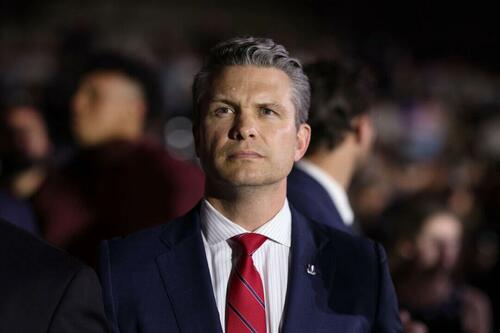 Defense Secretary Pete Hegseth in Michigan on April 29, 2025. Scott Olson/Getty Images
Defense Secretary Pete Hegseth in Michigan on April 29, 2025. Scott Olson/Getty Images
“Today, the Department will issue guidance to the Military Departments and Services ending the accession of individuals with a current diagnosis or history of, or symptoms consistent with, gender dysphoria and all non-medically necessary treatment,” said Defense Department spokesman Sean Parnell. The new policy marks a significant shift in military personnel standards and reflects President Donald J. Trump’s directive issued earlier this year. "Approximately 1,000 Service members who have self-identified as being diagnosed with gender dysphoria will begin the voluntary separation process."
The decision comes days after the U.S. Supreme Court, in a 6–3 vote, granted a stay of a lower court ruling that had blocked the policy. The majority did not issue an opinion, nor did the three dissenting justices. The stay allows the Department of Defense to enforce the new policy as litigation continues in a case brought by a group of transgender service members.
Defense Secretary Pete Hegseth defended the move as necessary for maintaining military readiness and cohesion. “This is the president’s agenda, this is what the American people voted for, and we’re going to continue to relentlessly pursue it,” Hegseth said in a video statement. In a memorandum dated May 8, he wrote that “service by individuals with a current diagnosis or history of, or exhibiting symptoms consistent with, gender dysphoria is not in the best interest of the Military Services and is not clearly consistent with the interests of national security.”
Under the new guidance, troops who self-identify by June 6 (active duty) or July 7 (reserves) will be eligible for voluntary separation and may receive separation pay. The deadline was extended from previous guidance by 30 and 60 days, respectively. Those seeking to remain in the military must obtain a waiver demonstrating that their continued service supports a compelling government interest and enhances warfighting capabilities. Among other requirements, waiver applicants must show they have not pursued gender transition and have demonstrated 36 consecutive months of psychological stability without significant distress.
Hegseth, speaking at a recent conservative conference in Florida, signaled a broader cultural shift within the military: “No more pronouns, no more climate change obsessions, no more emergency vaccine mandates, no more dudes in dresses,” he said.
. @SecDef We are leaving WOKENESS and WEAKNESS behind.
— DOD Rapid Response (@DODResponse) May 6, 2025
No more pronouns, no more climate change obsessions, no more emergency vaccine mandates, no more DUDES IN DRESSES.
We are done with that sh*t.” pic.twitter.com/MSunWnRYXUAdvocacy groups condemned the policy. “By allowing this discriminatory ban to take effect while our challenge continues, the Court has temporarily sanctioned a policy that has nothing to do with military readiness and everything to do with prejudice,” said Lambda Legal and the Human Rights Campaign Foundation, which are representing the transgender service members in court.
The military, which comprises roughly 2.1 million active and reserve personnel, had previously reversed a ban on transgender troops under President Joe Biden. The latest move effectively reimposes the Trump-era restrictions, with narrow pathways for exceptions.
-
Site: Zero HedgeTrump Seeking $1 Trillion In Saudi Investment, Air Force One En RouteTyler Durden Mon, 05/12/2025 - 19:15
US President Donald Trump is reportedly seeking $1 trillion in investments from Saudi Arabia in an upcoming visit to the energy-rich Gulf Kingdom. This comes amid reports that normalization between Riyadh and Tel Aviv has effectively "been delinked" from economic and security talks with Washington.
Trump has departed Monday on a four-day visit to Saudi Arabia, Qatar, and the United Arab Emirates, with the trip expected to center on securing business deals and attracting new investments from the oil-rich Gulf states. The president will not visit Israel.
Reuters reported Sunday that Saudi Arabia is unlikely to normalize relations with Israel at this time due to Israel's continuation of its war in Gaza and refusal to allow the establishment of a Palestinian state, according to US and Saudi officials. "Establishing ties has become especially toxic for Saudi Arabia, the birthplace of Islam, since the start of Israel's war in Gaza," Reuters wrote.
 Getty Images
Getty Images
US officials have failed to convince their Israeli counterparts to agree to an immediate ceasefire in Gaza – one of Saudi Arabia's preconditions for any re-start of normalization talks, two Gulf sources and a US official stated. Instead, Israeli leaders have expressed their desire to continue the war, which has killed well over 60,000 Palestinians, in an effort to ethnically cleanse Gaza of Palestinians and prepare it for Jewish settlement.
The reports contradict the optimism expressed by Trump's envoy to the region, Steve Witkoff, who told an audience at the Israeli embassy in Washington this week that he expected important progress on expanding the Abraham Accords, an agreement through which other Arab states, the UAE, Bahrain, Sudan, and Morocco, normalized relations with Israel.
"We think we will have some or a lot of announcements very, very shortly, which we hope will yield progress by next year," Witkoff said in a video of his speech before accompanying Trump on his trip to the region that will not include a visit to Israel.
As a result, Saudi normalization with Israel has "effectively been delinked from economic and other security matters between Washington and the kingdom, Reuters wrote, citing two Saudi and two US officials, all of whom requested to remain anonymous.
As a result, Trump's visit to the kingdom will focus on securing a trillion dollars' worth of Saudi investments in US companies, "including major deals in arms, mega-projects and artificial intelligence," Reuters wrote.
"The Trump administration wants this trip to be a big deal. That means lots of splashy deal announcements and collaborations that can be sold as being good for America," said Robert Mogielnicki, senior resident scholar at the Arab Gulf States Institute, a think tank in Washington.
"Normalizing ties with Israel is a much heavier lift than rolling out the red carpet for President Trump and announcing investment deals," he said. The Saudi government communications office did not reply to a request for comment, Reuters added.
A flashback to 8 years ago—May 2017, when President Trump last visited Saudi Arabia…pic.twitter.com/26TSu8bYXT
— Dan Scavino (@Scavino47) May 12, 2025In a related matter, an informed source told Palestinian newspaper Al-Quds on Sunday that the meeting between President Donald Trump and Saudi Crown Prince Mohammed bin Salman (MbS) in Riyadh on Tuesday will also include Palestinian President Mahmoud Abbas, Lebanese President Joseph Aoun, and Syrian President Ahmed al-Sharaa.
The source, who declined to be identified, said Crown Prince Mohammed bin Salman submitted the proposal, which received Trump's approval.
The source confirmed that MbS is looking forward to Trump's acceptance of the Saudi condition for the establishment of a Palestinian state, noting that achieving this would constitute one of the greatest and most important achievements of Saudi Arabia's active diplomacy.
-
Site: LifeNews
Operation Rescue has reported again and again about the catastrophic effects witnessed in Kansas after voters failed to pass a pro-life amendment in 2022, leaving abortion enshrined through all nine months of pregnancy in the state constitution.
Since then, common sense protections have been steadily stripped away while the number of abortion businesses increase, many offering abortion into the second trimester. In 2022, alone, Kansas saw a 57% increase in abortion.
Now, another state faces the same downward spiral.
Last November, Missouri voters failed to stop the passage of Amendment 3, which enshrined a right to abortion in their state constitution. While Kansas was the first state to hold a referendum on abortion after the fall of Roe, Missouri was the first abortion-free state to face a similar referendum – and lose established protections for the preborn.
Please follow LifeNews.com on Gab for the latest pro-life news and info, free from social media censorship.
The fallout was immediate. While it took Planned Parenthood almost a year to launch a legal attack on pro-life laws in Kansas, it took less than 24 hours after the Missouri amendment passed for the abortion giant to file a lawsuit seeking to enjoin the state’s abortion ban as well as other protective statutes, like requiring abortion facilities to be licensed, requiring only medical doctors to perform abortions, and giving women 72 hours before undergoing an abortion in order to deter coercion.
By February 2025 — just three months later — abortions were set to resume in this once abortion-free state, all protected by court-ordered injunctions until Planned Parenthood’s full case goes to trial in 2026.
“We know this pattern all too well,” says Troy Newman, President of Operation Rescue. “The abortion lobby pushes these amendments with dangerously ambiguous language, falsely reassuring voters it only wants to protect ‘freedom.’ But the abortion lobby only ever protects one thing: unregulated, unfettered, abortion – and always through all nine months.”
In May, another radical lawsuit was launched against the state. Right by You, a pro-abortion group that helps minors obtain abortions, is challenging Missouri’s parental notification laws, arguing that it violates Amendment 3.
In the months building up to the November 2024 election, Missouri Right to Life and others sounded the alarm that Amendment 3 would strip away parental rights. In fact, months before the vote, the Missouri Attorney General filed a lawsuit against Planned Parenthood for trafficking minors across state lines without their parents’ knowledge or consent.
The suit came in response to a video published by Project Veritas showing Planned Parenthood employees explaining how they “bypass” Missouri’s parental consent laws. In the video, employees speak to a man who came in the clinic to find out how to obtain an abortion for a 13-year-old girl. He states more than once that this girl is not his child and that her parents cannot find out. “We never tell the parents anything,” one employee says. “She’s an adult in our clinics.”
“Despite this shocking lawsuit and the adamant warnings from other pro-life groups within the state, Missouri voters clearly didn’t take these red flags seriously enough,” adds Newman. “And now, as predicted, parental consent laws are under threat.”
However, Missouri voters may get another chance to restore all previous pro-life protections. On April 15, the Missouri House voted in favor of another ballot measure for the upcoming election year – one that will put Missouri back on the list of abortion-free states.
The proposal, HJR73, still has to pass in the Senate before appearing on the ballot – and voters still have to show up at the polls. However, if successful, the amendment will reinstate near-total protection for children in the womb with narrow abortion exceptions for medical emergencies and fetal anomalies. Cases of rape or incest are also included, with abortion limited to the first 12 weeks of pregnancy.
As of May 12, there are five days left in this legislative session.
“If this amendment makes the ballot and passes,” adds Newman, “Missouri voters will not only restore life-saving protections for preborn children, they will also show the nation that these dangerous amendments shrouded in ambiguous language and designed to allow abortion through all nine months can be overturned and, ultimately, defeated. From someone living in a once pro-life state now devastated by unfettered abortion: Don’t waste this chance, Missouri.”
LifeNews Note: This article was originally published by Operation Rescue, a leading pro-life, Christian activist organization dedicated to exposing abortion abuses, demanding enforcement, saving innocent lives, and building an abortion-free America. The author, Sarah Neely, is Chief Operating Officer for Operation Rescue.

The post Missouri Has Another Chance to Protect Babies From Abortions appeared first on LifeNews.com.
-
Site: Rorate CaeliAldo Maria Valli, the former Vaticanist for Italian state broadcaster RAI (and very critical of the last pontificate, as every sensible Catholic), concluded his article today with these words:It seems to me that with Leo we returned to a “normal” pope. What does that mean? I was thinking about it these days. A “normal” pope is a pope who does not obscure the Church with his own image, but New Catholichttp://www.blogger.com/profile/04118576661605931910noreply@blogger.com
-
Site: LifeNews
Planned Parenthood released its 2023-2024 annual report on Monday, and it shows that Planned Parenthood continues to perform a record number of abortions.
The service figures in this latest annual report cover October 1, 2022, to September 30, 2023. This report is the first full account following the June 2022 U.S. Supreme Court decision in Dobbs v. Women’s Health Services that overturned Roe v. Wade.
The report shows that Planned Parenthood performed 402,230 abortions, or about 4 of every 10 abortions nationwide, and that abortions outnumbered prenatal care 57 to 1.
“Planned Parenthood performed a record number of abortions and continues to promote abortion for any reason and at any time,” said Carol Tobias, president of National Right to Life. “The abortion giant’s primary mission to destroy preborn children cannot be more clear.”
Tobias continued, “Rather than being ‘A Force for Hope,’ the nation’s largest abortion provider continues to perform abortions at an unprecedented rate, offering only a dead baby for a woman seeking help and hope.”
Please follow LifeNews.com on Gab for the latest pro-life news and info, free from social media censorship.
For the fiscal year ending June 30, 2024, Planned Parenthood took in $2.026 billion in revenue making the abortion giant one of the nation’s most profitable “non-profits.”
Planned Parenthood stopped offering abortion in some states but obviously more than made up for it by facilitating support for women who traveled to abortion-friendly states.
Of the over $2 billion in revenue, $792.2 million (39%) of Planned Parenthood’s revenue came from taxpayers in the form of “Government Health Services Reimbursements & Grants.”
“Planned Parenthood’s latest annual report shows that the abortion industry giant continues to put abortion above genuine pregnancy-related services,” said Randall K. O’Bannon, Ph.D., director of Education and Research for National Right to Life, one of the right-to-life movement’s most authoritative experts on the Planned Parenthood.
Most of Planned Parenthood’s expenses went toward “medical services,” which came in at $1.286 billion. It is impossible to estimate how much of these expenses were for performing abortions, because Planned Parenthood does not make these numbers public and the prices for abortions vary regionally at Planned Parenthood affiliates. In addition, the cost of different abortion procedures varies based on how old the unborn baby is at the time of the abortion, making even general calculations impossible.
Planned Parenthood’s annual report also shows that prenatal services and adoption referrals are still rare at Planned Parenthood:
- Just 7,008 women received prenatal care at Planned Parenthood clinics.
- Just 2,148 women were referred for adoptions.

The post Planned Parenthood Kills 57 Babies for Every Mom It Helps With Prenatal Care appeared first on LifeNews.com.
-
Site: Zero HedgeCoincidence? Top Two MMR-Vaccinated States Lead In 2025 Measles CasesTyler Durden Mon, 05/12/2025 - 17:40
Texas and New Mexico have had the sharpest increase in measles (MMR) vaccination so far in 2025 - they’ve also had the most measles cases.
That raises serious questions about what’s really driving these outbreaks - and whether the mainstream “solution” is making the problem worse.
Increased Vaccinations
-
Texas: From January 1 to March 16, 2025, Texas administered at least 173,000 doses of the measles vaccine, up from 158,000 during the same period in 2024—a roughly 9.5% increase.
-
New Mexico: According to the New Mexico Department of Health, between February 1 and March 31, 2025, 14,757 doses of the MMR (measles, mumps, rubella) vaccine were administered in New Mexico, compared to 8,162 during the same period in 2024—an 80.8% increase.
Increased Cases
-
Texas is the clear epicenter, with 709 cases reported as of early May, far surpassing any other state.
-
New Mexico has reported 71 confirmed measles cases, as of early May 2025, confirmed by the New Mexico Department of Health.
Live Virus, Live Risk: Infections Emerging After MMR Vaccination Campaigns Raise Alarms
JonFleetwood.com is exclusively keeping a running list of troubling patterns linking measles infections to recent government-led MMR vaccination campaigns across North America:
-
The MMR vaccine contains a live measles virus, according to the manufacturer.
-
The live measles virus in the MMR vaccine is the product of gain-of-function (GOF) laboratory experiments, meaning it is deliberately engineered to enhance its ability to infect more human cells than the wild-type measles virus can and may retain characteristics that enable transmission and replication in the vaccinated and unvaccinated alike.
-
The live virus in the vaccine can be shed for weeks from the vaccinated, potentially infecting the unvaccinated. A 1995 CDC study found that 83% of vaccinated children had measles virus shed in their urine. An April 2012 publication in the peer-reviewed journal Paediatrics & Child Health reported a child was being investigated after developing a new-onset measles-type rash after receiving a measles vaccine, meaning the shot can cause disease in the vaccinated. Nucleic acid testing confirmed that a “vaccine-type measles virus was being shed in the [child’s] urine.” A 2014 study in Clinical Infectious Diseases confirms that vaccinated individuals can transmit measles to multiple contacts.
-
There are no peer-reviewed studies that confirm the virus in the measles vaccine is less infectious or replicates less in humans than the wild-type virus found in nature, meaning health officials have no scientific basis for claiming the vaccine strain poses a lower transmission risk to the unvaccinated.
-
The claim that many of these measles cases are from wild-type measles viruses and not the live virus in the vaccine is undermined by the fact that the PCR test used as evidence of wild-type infection is only reliable less than 3% of the time. Research in Access Microbiology highlights that standard PCR assays might not effectively distinguish between vaccine and wild-type strains. The CDC has confirmed that PCR tests often misinterpret measles vaccine virus infection as wild-type measles infection: “Inability of these testing panels to differentiate between measles virus causing illness and incidental detection of measles vaccine virus RNA can have significant public health reporting and response ramifications, potentially leading to misdiagnosis of measles virus infection,” writes CDC.
-
Measles outbreaks have followed government-led vaccination campaigns in Texas, Canada, and Hawaii, raising concerns of vaccine-caused infections.
-
A 12-month-old girl in Michigan recently infected with measles had received an MMR vaccine.
-
Southern New Mexico’s most populous and vaccinated county, Doña Ana, recently reported its first measles infection after the state nearly doubled its measles vaccination rate compared to last year.
-
Virginia’s first confirmed measles case in 2025 occurred in a child following state and local health officials issuing multiple public health announcements urging residents to get the MMR shot.
-
Just weeks after the Illinois Department of Public Health (IDPH) rolled out a “measles simulator dashboard” meant to pressure students and residents into receiving MMR vaccines, Illinois reported its first confirmed measles case of 2025.
-
The Colorado Department of Public Health and Environment recently confirmed a fifth case of measles in Colorado this year in a Denver County adult resident with verified measles (MMR) vaccination records.
* * *
Please visit his Substack and subscribe to support his work. Follow Jon: Instagram @realjonfleetwood / Twitter @JonMFleetwood / Facebook @realjonfleetwood
-
-
Site: Zero HedgeTrump To Turkey? President Floats Joining Russia-Ukraine Peace TalksTyler Durden Mon, 05/12/2025 - 17:20
It yet another Ukraine peace talks related surprise, President Donald Trump on Monday floated the possibility of him traveling to Turkey to personally mediate negotiations between Russia and Ukraine, which are set for Thursday in Istanbul.
"I was thinking about actually flying over there," Trump said during a televised press conference on drug pricing. The words come after Ukraine's President Zelensky said he's ready to be there, and also challenged Putin to travel to the Turkish capital in person.
 AFP/Getty Images
AFP/Getty Images
"There’s a possibility of it, I guess, if I think things could happen," Trump added, and the caveat: "I would fly there if I thought it would be helpful,"
"Thursday’s meeting with Russia and Ukraine is really important," Trump said. "I was really insistent that that meeting take place. I think good things can come out of that meeting. Stop the bloodshed, it’s a bloodbath."
The White House is backing a 30-day ceasefire plan, in hopes that it would lead to a final end to the bloodshed, with detailed negotiations in the interim.
"I have a feeling they're going to agree. I do. I have a feeling," Trump also emphasized. The travel comments seemed more about displaying his personal optimism on new talks.
He didn't mention specifics or the challenge of logistics and setting up proper security, which can typically take days or weeks when it comes to presidential travel and coordination between the Secret Service and host nations.
President Trump is about to embark on a trip to Saudi Arabia, Qatar, and UAE - so a potential Turkey visit would require a stop-over upon the return trip.
Zelensky was quick to respond to Trump's public brainstorming, stating on X that "all of us in Ukraine would appreciate it if President Trump could be there with us at this meeting in Türkiye." He added: "I hope that the Russians will not evade the meeting."
It seems clear that in poking the Kremlin, Zelensky is really just seeking to performatively demonstrate to Washington and European allies that he's willing to engage in negotiations, after Trump has ramped up the pressure, and given Kiev desperately needs to continue securing Western weapons and support.
Turkey’s Erdogan has calls with Putin and Zelensky before DIRECT Russia-Ukraine talks pic.twitter.com/Gx42d6e5C4
— RT (@RT_com) May 12, 2025It remains that Zelensky has offered no big (territorial) concessions to end the war, so likely Putin isn't too interested in traveling to Turkey personally, for something which would likely in the end be a bust in terms of finalizing a peace settlement.
The Kremlin likely understands perfectly well that this is mostly Zelensky playing to the cameras, and seeking to satisfy Trump and 'reset' the relationship with the US. It's anything but clear whether Zelensky will actually be in Istanbul at this point.

